List of monarchs of Iran
Template:Short description Template:Infobox former monarchy

The monarchs of IranTemplate:Efn ruled for over two and a half millennia, beginning as early as the 7th century BC and enduring until the 20th century AD. The earliest Iranian king is generally considered to have been either Deioces of the Median dynasty (Template:Circa) or Cyrus the Great of the Achaemenid dynasty (550–330 BC). The last Iranian king was Mohammad Reza Pahlavi of the Pahlavi dynasty (1925–1979), which was overthrown by the Islamic Revolution. Since then, Iran has been governed as an Islamic republic.
In classical antiquity, Iran reached the peak of its power and prestige under the Achaemenid Empire, which stretched from Egypt and parts of Southeast Europe in the west to the Indus Valley and parts of Central Asia in the east. By 323 BC, the Achaemenid Empire's territories had been conquered by the Macedonian Empire during the Wars of Alexander the Great, bringing Iran into the Hellenistic sphere with the Seleucid Empire (305–129 BC). However, native Iranian rule was revived with the establishment and expansion of the Parthian Empire (247 BC–224 AD) and then the Sasanian Empire (224–651), which existed until the Arab conquest of Iran.
Medieval Iran alternated between being ruled by large foreign empires and being divided into several smaller kingdoms. Most of the Sasanian lands were annexed by the Rashidun Caliphate (638–661), which was succeeded by the Umayyad Caliphate (661–750) and then by the Abbasid Caliphate (749–861). Under the Abbasids, many Iranian figures took part in shaping the Islamic Golden Age, while also leveraging the decline of Arab power to establish independent dynasties and kingdoms, thus allowing their native languages to flourish and reviving Sasanian royal iconography and ideology in what became known as the Iranian Intermezzo. In the 11th century, Iran was conquered by the Seljuk Empire (1038–1194), which was Turkic in origin, but culturally Persianate. Further conquests by entities coming from Central Asia occurred over the course of the next five centuries, most notably including the Turkic Khwarazmian Empire (1097–1220/1221), the Mongol Empire (1220–1259), the post-Mongol Ilkhanate (1256–1335), and the Turkic Timurid Empire (1370–1458).
The year 1501 is considered the beginning of modern Iranian history, as the Kurdish-origin Safavid dynasty (1501–1736) rose to power and oversaw the conversion of Iran to Shia Islam, marking the region's largest religious shift since the Arab conquests. The collapse of the Safavids led to an intermediate period of turmoil, with rule of Iran contested between Safavid dynasts as well as the Afghan-origin Hotak dynasty (1722–1729). Nader Shah replaced these with the Afsharid Empire (1736–1796), but after his assassination in 1747, the Afsharids competed with the Zand dynasty (1751–1794) under Karim Khan Zand and his successors for supremacy. Iran was eventually reunified by the Qajar dynasty (1789–1925), which was succeeded by the Pahlavi dynasty of Reza Khan. The Pahlavi dynasty was the last to reign before the Iranian monarchy was abolished in 1979; Iran's head of state has since been the theocratic supreme leaders.
Ancient Iran (Template:Circa 727 BC–AD 651)
Medes (Template:Circa 727–550 BC)

The Median dynasty is traditionally considered to have ruled the earliest Iranian state.Template:SfnTemplate:SfnTemplate:Sfn Whether the Medes ruled an imperial state or merely a loose tribal confederation is disputed among historians.Template:Sfn Median history is reconstructed almost solely through ancient Greek sources (particularly Herodotus) and disregards Near Eastern sources, which are fragmentary and do not support the existence of a unified Median Empire.Template:Sfn There is also no material or textual evidence left behind by the supposed empire itself.Template:SfnTemplate:Efn The chronology and names of the Median kings mainly derives from the work of Herodotus.Template:SfnTemplate:Efn
No ruling title is securely attested for the Median rulers. They might have used šāhān šāh "King of Kings", the Middle Persian reflex of the Achaemenid title xšāyaθiya xšāyaθiyānām.Template:Sfn Ecbatana was the Median capital.Template:Sfn
| Portrait | Name | Reign | Succession |
|---|---|---|---|
| Template:Centre | Deioces | Template:Circa 727–675 BCTemplate:Sfn (Template:Circa 52 years) |
First king of the Medes according to Herodotus. Perhaps elected by popular assembly.Template:Sfn |
| Template:Centre | Phraortes | Template:Circa 674–653 BCTemplate:Sfn (Template:Circa 21 years) |
Son of DeiocesTemplate:Sfn |
| Interregnum Template:Circa 652 – 625 BCTemplate:Sfn The Medes were invaded by Scythians, perhaps under a ruler named Madyes, who established some form of hegemony.Template:Sfn The Scythian rulers were defeated by Cyaxares after about three decades, restoring the Medes to their previous power.Template:Sfn | |||

|
Cyaxares | Template:Circa 624–585 BCTemplate:Sfn (Template:Circa 39 years) |
Son of PhraortesTemplate:Sfn |
| Template:Centre | Astyages | Template:Circa 584Template:Sfn–550 BCTemplate:Sfn (Template:Circa 34 years) |
Son of CyaxaresTemplate:Sfn |
| Portrait | Name | Tenure | Succession |
|---|---|---|---|

|
Phraortes II | 521 BCTemplate:Sfn (less than a year) |
Rebel in Media against Darius I of the Achaemenid Empire. Claimed kinship with Cyaxares.Template:Sfn |

|
Tritantaechmes | 521 BCTemplate:Sfn (less than a year) |
Rebel in Sagartia against Darius I of the Achaemenid Empire. Claimed kinship with Cyaxares.Template:Sfn |
Achaemenid Empire (550–330 BC)

The Achaemenid dynasty originated as local rulers of Anshan under Median suzerainty. They are attributed various ancestors in later legends, including an eponymous figure called "Achaemenes". The earliest securely historical Achaemenid ruler is Cyrus I, king of Anshan in the second half of the seventh century BC.Template:Sfn The Achaemenids united all Persian tribes under Cyrus I's son Cambyses I. Under Cambyses I's son, Cyrus II, the Achaemenids defeated the Medes and established the Achaemenid Empire,Template:Sfn the largest ever Iranian state.Template:Sfn
The standard title used by Achaemenid rulers in Iran from Cyrus II onwards was xšāyaθiya xšāyaθiyānām, xšāyaθiya dahyūnām (Template:Literal translation).Template:Sfn The royal title varied in other parts of the empire.Template:Efn The Achaemenids had several royal cities, including Pasargadae, Susa, Ecbatana, Babylon, Bactra, and Persepolis.Template:Sfn
| Portrait | Name | Reign | Succession |
|---|---|---|---|

|
Cyrus I | Template:Circa 620–590 BCTemplate:Sfn (Template:Circa 30 years) |
Earliest historical Achaemenid rulerTemplate:Sfn |
| Template:Centre | Cambyses I | Template:Circa 590–559 BCTemplate:Sfn (Template:Circa 31 years) |
Son of Cyrus ITemplate:Sfn |

|
Cyrus II | Template:Circa 559Template:Sfn–550 BCTemplate:Sfn (Template:Circa 9 years) |
Son of Cambyses ITemplate:Sfn |
| Portrait | Name | Reign | Succession |
|---|---|---|---|

|
Cyrus II the Great |
Template:Circa 550Template:Sfn – November (?) 530 BCTemplate:Sfn (Template:Circa 20 years) |
Defeated Astyages and captured Ecbatana Template:Circa 550 BC.Template:Sfn Married Amytis, daughter of Astyages, according to ancient Greek historians.Template:Sfn |

|
Cambyses II | August 530 – July 522 BCTemplate:Sfn (Template:Age in years, months and days) |
Son of Cyrus IITemplate:Sfn |

|
Bardiya | 1 July – 29 September 522 BCTemplate:Sfn (Template:Age in years, months and days) |
Son of Cyrus II (possibly an impostor).Template:Sfn Revolted against Cambyses on 11 March 522 BC and proclaimed himself ruler on 1 July.Template:Sfn |

|
Darius I the Great |
29 September 522Template:Sfn – October 486 BCTemplate:Sfn (Template:Age in years, months and days) |
Claimed descent from Teispes (supposed father of Cyrus I). Seized the throne from Bardiya.Template:Sfn |

|
Xerxes I the Great |
October 486Template:Sfn – August 465 BCTemplate:Sfn (Template:Age in years, months and days) |
Son of Darius ITemplate:Sfn and Atossa (daughter of Cyrus II)Template:Sfn |

|
Artaxerxes I Longimanus |
August 465Template:Sfn – Template:Circa December 424 BCTemplate:Sfn (41 years and Template:Circa 4 months) |
Son of Xerxes ITemplate:Sfn |
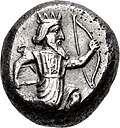
|
Xerxes II | Template:Circa December 424 – Template:Circa January 423 BCTemplate:Sfn (45 days)Template:Sfn |
Son of Artaxerxes ITemplate:Sfn |

|
Sogdianus | Template:Circa January – February 423 BCTemplate:Sfn (Template:Circa 1 month) |
Illegitimate son of Artaxerxes I.Template:Sfn Seized the throne from Xerxes II.Template:Sfn |

|
Darius II (Ochus) |
February 423 – March 404 BCTemplate:Sfn (Template:Age in years, months and days) |
Illegitimate son of Artaxerxes I.Template:Sfn Seized the throne from Sogdianus.Template:Sfn |

|
Artaxerxes II (Arsakes) |
March 404Template:Sfn – spring (?) 358 BCTemplate:Sfn (46 years) |
Son of Darius IITemplate:Sfn |
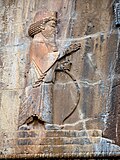
|
Artaxerxes III (Ochus) |
Spring (?) 358 – September (?) 338 BCTemplate:Sfn (20 years) |
Son of Artaxerxes IITemplate:Sfn |

|
Artaxerxes IV (Arses) |
September (?) 338 – June 336 BCTemplate:Sfn (2 years) |
Son of Artaxerxes IIITemplate:Sfn |
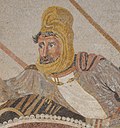
|
Darius III (Artashata) |
June 336Template:Sfn – July 330 BCTemplate:Sfn (6 years) |
Great-grandson of Darius IITemplate:Sfn |
| Portrait | Name | Tenure | Succession |
|---|---|---|---|

|
Artaxerxes V (Bessus) |
July 330Template:Sfn – spring 329 BCTemplate:Sfn (less than a year) |
Satrap of Bactria,Template:Sfn part of the Achaemenid dynasty.Template:Sfn Murdered Darius III and proclaimed himself as his successor, ruling several eastern satrapies in opposition to Alexander the Great.Template:Sfn |
Hellenistic rule (331–129 BC)
Alexander's empire (331–305 BC)

The Achaemenid Empire was defeated and conquered by Alexander the Great, king of Macedonia, in 331Template:Sfn–329 BC.Template:Sfn After Alexander's death in 323 BC, the Wars of the Diadochi broke out between his successors, leading to the rapid disintegration of the empire.Template:Sfn
Alexander did not assume the former Achaemenid royal title of 'King of Kings'.Template:SfnTemplate:Sfn His main royal title, appearing on coins intended for his Asian territories, was instead basileus (Template:Literal translation).Template:Sfn To mark his rule over the Achaemenid territories he also sometimes used the new title "Lord of Asia" (sometimes "King of Asia").Template:Sfn The only royal title recorded for Alexander's two immediate heirs is basileus.Template:Sfn Alexander ruled his empire from BabylonTemplate:Sfn and planned to establish Babylon and Alexandria in Egypt as the twin imperial capitals.Template:Sfn From 319 BC onwards, Alexander's heirs resided in Macedonia while the regency in Asia was contested by several generals.Template:Sfn
| Portrait | Name | Reign | Succession |
|---|---|---|---|

|
AlexanderTemplate:Efn the Great |
1 October 331Template:SfnTemplate:Efn – 10/11 June 323 BCTemplate:Sfn (7 years, 8 months and 10/11 days) |
Conquered the Achaemenid EmpireTemplate:Sfn |

|
Philip ArrhidaeusTemplate:Efn | June 323 – late 317 BCTemplate:Sfn (6 years) |
Brother of Alexander the GreatTemplate:Sfn |

|
Alexander AegusTemplate:Efn | August 323Template:Sfn – 309 BCTemplate:Sfn (305 BC)Template:Efn (14 years, recognized for 18 years) |
Son of Alexander the GreatTemplate:Sfn |
Seleucid Empire (305–129 BC)
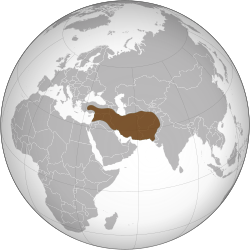
The main Hellenistic successors of Alexander's empire in Iran were the Seleucids, descendants of the Macedonian general Seleucus I Nicator and the Iranian noblewoman Apama.Template:Sfn Seleucus seized most of the east, including Babylonia, in the Wars of the Diadochi and was firmly in control in the region from 312 BC onwards.Template:Sfn After Alexander IV's death became public knowledge in 305 BC, Seleucus proclaimed himself king.Template:Sfn
The main royal title used by the Seleucids was basileus, as was the case for the other Macedonian successor kingdoms (such as the Ptolemaic Kingdom).Template:Sfn Only two Seleucid rulers (Antiochus III, 223–187 BC, and Antiochus VII, 139–129 BC) used the greater megas basileus ('Great King'),Template:Sfn the style applied to Achaemenid kings in ancient Greek sources.Template:Sfn The Seleucids at first ruled from Seleucia in Mesopotamia, though Antioch was soon made the main capital.Template:Sfn
| Portrait | Name | Reign | Succession |
|---|---|---|---|

|
Seleucus I Nicator |
305Template:Sfn – September 280 BCTemplate:Sfn (25 years) |
Former general under Alexander the Great. Held most of the east of his empire from 312 BC onwardsTemplate:Sfn and proclaimed king in 305 BC.Template:Sfn |

|
Antiochus I Soter |
September 280 – 261 BCTemplate:Sfn (19 years) |
Son of Seleucus ITemplate:Sfn |
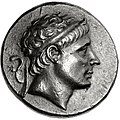
|
Antiochus II Theos |
261–246 BCTemplate:Sfn (15 years) |
Son of Antiochus ITemplate:Sfn |

|
Seleucus II Callinicus |
246–226 BCTemplate:Sfn (20 years) |
Son of Antiochus IITemplate:Sfn |

|
Seleucus III Ceraunus |
226–223 BCTemplate:Sfn (3 years) |
Son of Seleucus IITemplate:Sfn |
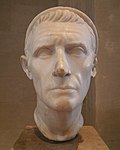
|
Antiochus III the Great |
223–187 BCTemplate:Sfn (36 years) |
Son of Seleucus IITemplate:Sfn |

|
Seleucus IV Philopator |
187–175 BCTemplate:Sfn (12 years) |
Son of Antiochus IIITemplate:Sfn |

|
Antiochus IV Epiphanes |
175 – late 164 BCTemplate:Sfn (11 years) |
Son of Antiochus IIITemplate:Sfn |
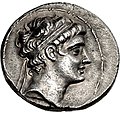
|
Antiochus V Eupator |
Late 164 – 162 BCTemplate:Sfn (2 years) |
Son of Antiochus IVTemplate:Sfn |

|
Demetrius I Soter |
162–150 BCTemplate:Sfn (12 years) |
Son of Seleucus IV. Overthrew Antiochus IV.Template:Sfn |

|
Alexander Balas |
152–145 BCTemplate:Sfn (7 years) |
Alleged son of Antiochus IV. Rival king against Demetrius I, supported by the Roman Empire.Template:Sfn |

|
Antiochus VI Dionysus |
145–142 BCTemplate:Sfn (3 years) |
Son of Alexander BalasTemplate:Sfn |

|
Demetrius II Nicator |
147–139 BCTemplate:Sfn (8 years) |
Son of Demetrius I. Revolted against Alexander Balas with support from the Ptolemaic Kingdom. Sole king after Antiochus VI's death.Template:Sfn |
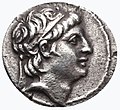
|
Antiochus VII Sidetes |
139–129 BCTemplate:Sfn (10 years) |
Son of Demetrius ITemplate:Sfn |
Parthian Empire (Template:Circa 250/247 BC–224 AD)

The Arsacids of Parthia,Template:Sfn initially Seleucid vassals,Template:Sfn originated as leaders of the IranianTemplate:Efn Parni tribe in the northeastern steppes.Template:Sfn The Parthians gradually challenged Seleucid rule over Iran.Template:Sfn Parthian control of Iran was secured through the Template:Circa 142 BC conquest of Babylonia.Template:SfnTemplate:Sfn Although fighting continued for years, the death of Antiochus VII Sidetes in 129 BC effectively marked the collapse of the Seleucid Empire,Template:Sfn which then lingered on as a rump state in Syria until conquered by the Roman Empire in the 60s BC.Template:Sfn
The Parthians presented themselves as heirs of the Achaemenids, though ruled a much more decentralized state.Template:Sfn Greek inscriptions were used on Parthian coins until the time of Vologases I (AD 51–78).Template:Sfn Early Parthian rulers used the name of their dynastic founder (Arsaces) as a title. Their coins also have the legend krny (probably short for autokrator, i.e. autocrat or sole ruler).Template:Sfn From the conquest of Babylonia onwards, rulers used basileus megas (Template:Literal translation).Template:Sfn Mithridates II (123–91 BC) adopted the Achaemenid 'King of Kings' (rendered in Greek as basileus basileon). After him, this title was used only by Mithridates IV (57–54 BC) and Orodes II (57–37 BC) before becoming a standard part of the Parthian title from the time of Phraates IV (26–2 BC) onwards.Template:Sfn The title was used in its Persian form (šāhān šāh) after Greek ceased being used.Template:Sfn The first Parthian capital was at Nisa in Parthia. In 217 BC, the capital was moved to Qumis and in 50 BC a multi-capital system was established, with royal residences at Ctesiphon, Ecbatana, and Ray.Template:Sfn
This list omits rival kings and claimants. Because of poor source material there are alternate chronologies, genealogies, and enumerations of Parthian rulers, with some differences. See the list of monarchs of Parthia.
| Portrait | Name | Reign | Succession |
|---|---|---|---|

|
Arsaces I | Template:Circa 250/247–217 BCTemplate:Sfn (30–33 years) |
Conquered Parthia from the Seleucid satrap AndragorasTemplate:Sfn |

|
Arsaces II | Template:Circa 217–191 BCTemplate:Sfn (26 years) |
Son of Arsaces ITemplate:Sfn |
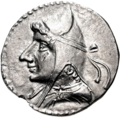
|
Priapatius | Template:Circa 191–176 BCTemplate:Sfn (15 years) |
Grandson of a brother of Arsaces ITemplate:Sfn |

|
Phraates I | Template:Circa 176–171 BCTemplate:Sfn (5 years) |
Son of PriapatiusTemplate:Sfn |

|
Mithridates I | Template:Circa 171Template:Sfn–142 BCTemplate:SfnTemplate:Efn (29 years) |
Son of PriapatiusTemplate:Sfn |
| Portrait | Name | Reign | Succession |
|---|---|---|---|

|
Mithridates I the Great |
Template:Circa 142Template:SfnTemplate:Efn–132 BCTemplate:Sfn (Template:Circa 10 years) |
Established Parthia as an empire.Template:Sfn Conquered the Iranian plateau in the 160s BC,Template:Sfn followed by conquests of Babylonia (142 BC),Template:Sfn Media (141 BC), and Persis (139 BC).Template:Sfn |

|
Phraates II | Template:Circa 132–127 BCTemplate:Sfn (5 years) |
Son of Mithridates ITemplate:Sfn |
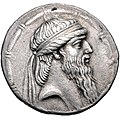
|
Artabanus ITemplate:Efn | Template:Circa 127–124/123 BCTemplate:Sfn (3–4 years) |
Son of Priapatius (and brother of Mithridates I)Template:Sfn |

|
Mithridates II the Great |
Template:Circa 123–91 BCTemplate:Sfn (Template:Circa 32 years) |
Son of Artabanus ITemplate:Sfn |

|
Gotarzes I | 91–87(?) BCTemplate:Sfn (Template:Circa 4 years) |
Son of Priapatius (and brother of Mithridates I and Artabanus I)Template:Sfn |

|
Orodes I | 87–79(?) BCTemplate:Sfn (Template:Circa 8 years) |
Son of Gotarzes I or Mithridates II (?)Template:Sfn |

|
Sinatruces | Template:Circa 78–70 BCTemplate:Sfn (Template:Circa 8 years) |
Son of Mithridates I, previously a rival claimant c. 91–88 BCTemplate:Sfn |
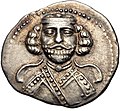
|
Phraates III | 70–57 BCTemplate:Sfn (13 years) |
Son of SinatrucesTemplate:Sfn |

|
Mithridates IIITemplate:Efn | 57–54 BCTemplate:Sfn (3 years) |
Son of Phraates III.Template:Sfn Co-ruler with his brother Orodes II until killed in 54 BC.Template:Sfn |
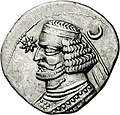
|
Orodes II | 57–37 BCTemplate:Sfn (20 years) |
Son of Phraates IIITemplate:Sfn |

|
Phraates IV | 37–32(?) BCTemplate:Sfn (1st reign) (5 years?) |
Son of Orodes IITemplate:Sfn |

|
TiridatesTemplate:Efn | 32–31(?) BCTemplate:Sfn (1st reign) (1 year?) |
Part of the Arsacid dynasty but of unclear lineageTemplate:Sfn |

|
Phraates IV | 31–28(?) BCTemplate:Sfn (2nd reign) (3 years?) |
Retook the throneTemplate:Sfn |

|
TiridatesTemplate:Efn | 28–26(?) BCTemplate:Sfn (2nd reign) (2 years?) |
Retook the throneTemplate:Sfn |

|
Phraates IV | 26(?)–2 BCTemplate:Sfn (3rd reign) (24 years?) |
Retook the throneTemplate:Sfn |
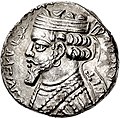
|
Phraates V | 2 BC – AD 4(?)Template:Sfn (6 years?) |
Son of Phraates IV, co-ruler with MusaTemplate:Sfn |

|
Musa | 2 BC – AD 4(?)Template:Sfn (6 years?) |
Widow of Phraates IV, co-ruler with Phraates V.Template:Sfn First of only four women to rule in Iranian history.Template:Efn |

|
Orodes III | 4(?)–6/7Template:Sfn (2/3 years?) |
Part of the Arsacid dynasty but of unclear lineageTemplate:Sfn |
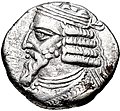
|
Vonones I | 6/7–11/12Template:Sfn (4–6 years) |
Son of Phraates IV, nominated as king by the Roman EmpireTemplate:Sfn |

|
Artabanus IITemplate:Efn | 11/12–38Template:Sfn (26/27 years) |
Cousin of VononesTemplate:Sfn |

|
Gotarzes II | 38–51Template:Sfn (13 years) |
Son of Artabanus (?)Template:Sfn |

|
Vardanes | 39–45/46Template:Sfn (6/7 years) |
Son of Artabanus (?).Template:Sfn Rival and later co-ruler of the empire with Gotarzes.Template:Sfn |
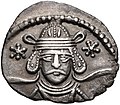
|
Vonones II | 51Template:Sfn (briefly) |
Part of the Arsacid dynasty but of unclear lineageTemplate:Sfn |

|
Vologases I | 51–78Template:Sfn (27 years) |
Son of VardanesTemplate:Sfn |

|
PacorusTemplate:Efn | 78–79Template:Sfn (1st reign) (1 year) |
Son of Vologases ITemplate:Sfn |

|
Artabanus IIITemplate:Efn | 79–81Template:Sfn (2 years) |
Son or brother of Vologases ITemplate:Sfn |

|
PacorusTemplate:Efn | 81–115Template:Sfn (2nd reign) (34 years) |
Retook the throneTemplate:Sfn |
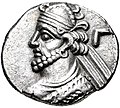
|
Vologases IITemplate:Efn | 115–116Template:Sfn (1 year) |
Son of PacorusTemplate:Sfn |

|
Parthamaspates | 116–117Template:Sfn (1 year) |
Grandson of Pacorus, installed as king by the Roman EmpireTemplate:Sfn |

|
Osroes | 117–128Template:Sfn (11 years) |
Son of Pacorus and father of ParthamaspatesTemplate:Sfn |

|
Mithridates IVTemplate:Efn | 128–148Template:Sfn (20 years) |
Part of the Arsacid dynasty but of unclear lineageTemplate:Sfn |

|
Vologases IIITemplate:Efn | 148–191Template:Sfn (43 years) |
Son of Mithridates IVTemplate:Sfn |

|
Vologases IVTemplate:Efn | 191–207Template:Sfn (16 years) |
Son of Vologases IIITemplate:Sfn |

|
Vologases VTemplate:Efn | 207–213Template:Sfn (6 years) |
Son of Vologases IV.Template:Sfn Possibly still in control of some parts of the empire by 228.Template:Sfn |

|
Artabanus IVTemplate:Efn | 213Template:Sfn–224Template:Sfn (11 years) |
Son of Vologases IV.Template:Sfn Fought with Vologases V over control of the empire.Template:Sfn |
Sasanian Empire (224 AD–651 AD)

The Sasanian dynasty originated as kings of Persis, a Parthian vassal kingdom, and claimed Achaemenid descent. In 224–226, the Sasanian dynast Ardashir I led a revolt against the Parthians, weakened in a recent civil war, and took control of the empire. Ardashir presented himself as a restorer of both regional unity and Achaemenid glory.Template:Sfn The Sasanian Empire was a significantly more militarily powerful, centralized, and aggressive state than the Parthian Empire and was also marked by a state-backed and less heterodox form of the Zoroastrian religion.Template:Sfn
Sasanian kings continued to use the title šāhān šāh (Template:Literal translation).Template:SfnTemplate:Full citation needed The title was extended by Ardashir to šāhān šāh ērān (Template:Literal translation)Template:Sfn and extended again by his son Shapur I (240–270) to šāhān šāh ērān ud anērān (Template:Literal translation).Template:SfnTemplate:Sfn Sasanian queens ruled with the title bānbišnān bānbišn ērān ud anērān (Template:Literal translation).Template:Sfn Ctesiphon was the capital of the Sasanian Empire.Template:Sfn
| Portrait | Name | Reign | Succession |
|---|---|---|---|

|
Ardashir I the Unifier |
224 – May 240Template:SfnTemplate:Sfn (16 years) |
Defeated Artabanus IV and took control of the empireTemplate:Sfn |

|
Shapur I | May 240 – May 270Template:Sfn (30 years) |
Son of Ardashir ITemplate:Sfn |

|
Hormizd I | May 270 – June 271Template:Sfn (1 year and 1 month) |
Son of Shapur ITemplate:Sfn |

|
Bahram I | June 271 – 274Template:Sfn (3 years) |
Son of Shapur ITemplate:Sfn |

|
Bahram II | 274–293Template:Sfn (19 years) |
Son of Bahram ITemplate:Sfn |
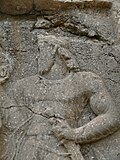
|
Bahram III | 293Template:Sfn (4 months) |
Son or cousin of Bahram IITemplate:Sfn |

|
Narseh | 293–302Template:Sfn (9 years) |
Son of Shapur ITemplate:Sfn |

|
Hormizd II | 303–309/310Template:Sfn (6/7 years) |
Son of NarsehTemplate:Sfn |
| Template:Centre | Adur Narseh (Narseh II) |
309/310Template:Sfn (briefly) |
Son of Hormizd IITemplate:Sfn |

|
Shapur II the Great |
310–379Template:Sfn (69 years) |
Son of Hormizd II, acclaimed ruler at birth.Template:Sfn The longest-reigning Iranian monarch. |

|
Ardashir II the Beneficent |
379–383Template:Sfn (4 years) |
Son of Hormizd IITemplate:Sfn |
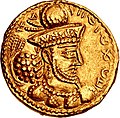
|
Shapur III | 383–388Template:Sfn (5 years) |
Son of Shapur IITemplate:Sfn |

|
Bahram IV | 388–399Template:Sfn (11 years) |
Son of Shapur IITemplate:Sfn |
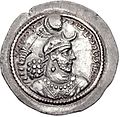
|
Yazdegerd I the Sinner |
399–420Template:Sfn (21 years) |
Son of Shapur IIITemplate:Sfn |

|
Shapur IV | 420Template:Sfn (briefly) |
Son of Yazdegerd ITemplate:Sfn |
| Template:Centre | Khosrow (I)Template:Efn | 420Template:Sfn (briefly) |
Son of Bahram IVTemplate:Sfn |

|
Bahram V the Onager |
420–438Template:Sfn (18 years) |
Son of Yazdegerd ITemplate:Sfn |

|
Yazdegerd II | 438–457Template:Sfn (19 years) |
Son of Bahram VTemplate:Sfn |

|
Hormizd III | 457Template:Sfn (briefly) |
Son of Yazdegerd IITemplate:Sfn |

|
Peroz I | 457–484Template:Sfn (27 years) |
Son of Yazdegerd IITemplate:Sfn |

|
Balash | 484–488Template:Sfn (4 years) |
Son of Yazdegerd IITemplate:Sfn |

|
Kavad I | 488–497Template:Sfn (1st reign) (9 years) |
Son of PerozTemplate:Sfn |

|
Jamasp | 497–499Template:Sfn (2 years) |
Son of PerozTemplate:Sfn |

|
Kavad I | 499–531Template:Sfn (2nd reign) (32 years) |
Restored to the throne with Hepthalite supportTemplate:Sfn |
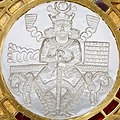
|
Khosrow I Anushirvan (Template:Literal translation) |
531–579Template:Sfn (48 years) |
Son of Kavad ITemplate:Sfn |

|
Hormizd IV | 579–590Template:Sfn (11 years) |
Son of Khosrow ITemplate:Sfn |

|
Bahram VI Chobin | 590–591Template:Sfn (1 year) |
General of Parthian descent (House of Mihran)Template:Sfn |

|
Khosrow II Parviz (Template:Literal translation) |
June 590 – 28 February 628Template:Sfn (Template:Age in years, months and days) |
Son of Hormizd IVTemplate:Sfn |

|
Vistahm | 591–597Template:Sfn (6 years, usurper in the east) |
General of Parthian descent (House of Ispahbudhan) and maternal uncle of Khosrow II. Rival king.Template:Sfn |

|
Kavad II | 28 February 628 – 628Template:Sfn (less than a year) |
Son of Khosrow II, overthrew his fatherTemplate:Sfn |

|
Ardashir III | 628–630Template:Sfn (2 years) |
CousinTemplate:Sfn or sonTemplate:Sfn of Kavad II |

|
Shahrbaraz | 630Template:Sfn (less than a year) |
General of Parthian descent (House of Mihran)Template:Sfn |

|
Khosrow III | 630Template:Sfn (less than a year) |
Nephew of Khosrow IITemplate:Sfn |

|
Boran | 630Template:Sfn (less than a year) |
Daughter of Khosrow II.Template:Sfn Second of only four women to rule in Iranian history.Template:Efn |
| Template:Centre | Shapur V | 630Template:Sfn (less than a year) |
Son of ShahrbarazTemplate:Sfn |

|
Azarmidokht | 630–631Template:Sfn (1 year) |
Daughter of Khosrow II.Template:Sfn Third of only four women to rule in Iranian history.Template:Efn |

|
Farrukh Hormizd V | 631–632Template:Sfn (1 year) |
General of Parthian descent (House of Ispahbudhan). Attempted to seize the throne after Azarmidokht declined his marriage proposal.Template:Sfn |

|
Hormizd VI | 630–632Template:Sfn (2 years, usurper in Nisibis) |
Grandson of Khosow II.Template:Sfn Proclaimed ruler by the Sasanian troops stationed at Nisibis.Template:Sfn |

|
Khosrow IV | 632Template:Sfn (less than a year) |
Great-nephew of Hormizd IVTemplate:Sfn |
| Template:Centre | Peroz II | 632–632/633Template:Sfn (1 year?) |
Brother of Khosrow IVTemplate:Sfn |

|
Farrukhzad Khosrow V | 632/633–Template:Circa 633Template:Sfn (1 year?) |
Brother of Hormizd VTemplate:Sfn |

|
Yazdegerd III | Template:Circa 633–651Template:Sfn (Template:Circa 18 years) |
Grandson of Khosrow IITemplate:Sfn |
| Portrait | Name | Tenure | Succession |
|---|---|---|---|

|
Peroz III | 651–678/679Template:Sfn (27/28 years) |
Son of Yazdegerd III, lived in exile in China (Tang dynasty) and led Iranian resistance against the Arabs. Recognized by the Tang dynasty as "king of Persia".Template:Sfn Ruled a Tang-supported Iranian kingdom in Sistan or TokharistanTemplate:Sfn 661–674.Template:Sfn |
| Template:Centre | Narsieh (Narseh III) |
678/679Template:Sfn–after 708/709Template:Sfn (over 20 years) |
Son and successor of Peroz III.Template:Sfn Crowned by the Chinese general Pei Xingjian and placed in charge of Tokharistan. Narsieh defended the region for twenty years until defeated by the Arabs in 708/709, whereafter he returned to China.Template:Sfn |
| Template:Centre | Bó Qiāng HuóTemplate:Efn | Template:Floruit 723Template:Sfn | Son of Narsieh.Template:Sfn Recorded in Chinese sources as "king of Persia" and as being active in Tokharistan against the Arabs in 723.Template:Sfn |
| Template:Centre | Mù ShānuòTemplate:Efn | Template:Floruit 726–731Template:Sfn | Recorded in Chinese sources as "king of Persia" and as being active in Tokharistan against the Arabs in 726 and 731.Template:Sfn Names of Sasanian claimants disappear from Chinese sources after 731.Template:Sfn |
Minor kingdoms and dynasties
- The Fratarakas (3rd–mid-2nd century BC), rulers/governors in Persis under the Seleucid Empire
- Rulers of Parthian sub-kingdoms (2nd century BC–5th century AD), various local vassal dynasties of the Parthian Empire
- The kings of Persis (2nd century BC–3rd century AD), vassal kings in Persis under the Parthian Empire
Medieval Iran (651–1501)
Template:See also The fall of the Sasanian Empire in 651 was followed by nearly a millennium without Iranian political unity, until the rise of the Safavid Empire in 1501.Template:SfnTemplate:Sfn In the intervening period, the territories formerly part of the ancient Iranian empires were variously subjected to larger foreign empires or divided into several smaller political units.Template:Sfn Although no unified Iranian state existed, shared Iranian identity, culture, and language continued to survive and develop throughout the Middle Ages.Template:SfnTemplate:Sfn
The medieval dynasties and kingdoms featured in this list follow a 2012 list of Iranian ruling dynasties by the Iranologist Touraj Daryaee.Template:Sfn
Arab (caliphal) rule (638–861)
Rashidun Caliphate (638–661)

The Muslim conquest of Persia began when the armies of the Rashidun Caliphate attacked parts of Sasanian Asoristan in 633.Template:Sfn In 637/638, the Sasanians lost MesopotamiaTemplate:Sfn The empire itself was conquered in 640–650.Template:SfnTemplate:Sfn By the time of Yazdegerd III's death in 651, the Sasanians only retained Bactria.Template:Sfn Following the Muslim victory, the Sasanian Empire was dissolved and Iran came under the direct rule of the Rashid caliphs.Template:Sfn Although the caliphs implemented forms of ethnic stratification that discriminated against Iranians and their culture, particularly during the later Umayyad Caliphate (661–750), they also adopted much of the old Sasanian administrative model to govern their empire.Template:Sfn
The style of the caliphs was amīr al-mu'minīn (Template:Literal translation).Template:Sfn An additional title, khalīfat Allāh (Template:Literal translation), was also introduced beginning with Uthman (644–656).Template:Sfn The caliphate was initially ruled from Medina. Under Ali, the capital was transferred to Kufa in Iraq.Template:Sfn
| Portrait | Name | Reign | Succession |
|---|---|---|---|

|
Umar | 637/638Template:Sfn – 3 November 644Template:Sfn (6/7 years) |
Second Rashid caliph.Template:Sfn Oversaw the initial Muslim conquest of Persia.Template:Sfn |

|
Uthman | 3 November 644 – 17 June 656Template:Sfn (Template:Age in years, months and days) |
Chosen by tribal acclamation. Challenged by Ali.Template:Sfn |

|
Ali | 18 June 656 – 28 January 661Template:Sfn (Template:Age in years, months and days) |
Caliph after Uthman's assassination. Challenged by Mu'awiya.Template:Sfn |

|
Hasan | 28 January – August 661Template:Sfn (Template:Age in years, months and days) |
Son of Ali and grandson of Muhammad.Template:Sfn Challenged by Mu'awiya.Template:Sfn |
Umayyad Caliphate (661–750)

The Umayyad Caliphate was established by Mu'awiya I, governor of Syria under the Rashidun caliphs. Mu'awiya opposed the acclamations of Ali and Hasan as caliphs,Template:Sfn leading to the civil war known as the First Fitna (656–661).Template:Sfn Mu'awiya was victorious and became undisputed caliph after Hasan relinquished his claims.Template:Sfn
Umayyad caliphs continued to use the styles amīr al-mu'minīn and khalīfat Allāh.Template:Sfn The Umayyad Caliphate was ruled from Damascus, though the capital was briefly transferred to Harran under the last caliph, Marwan II.Template:Sfn
Abbasid Caliphate (749–861)

Because Mu'awiya took power in civil war, the rights of his and his descendants to the caliphate was long questioned. Anti-Umayyad insurrections were to a large degree supported by non-Arab converts to Islam (especially Iranians) who were resentful over being relegated to lower social standing. In 747–750, one of these insurrections grew into the Abbasid revolution, in which the Umayyads were replaced with the Abbasids, descendants of Muhammad's uncle Abbas.Template:Sfn
Abbasid caliphs continued to use the styles amīr al-mu'minīn and khalīfat Allāh.Template:Sfn The Abbasid Caliphate was ruled from Kufa, until the capital was transferred to the newly-founded Baghdad in 762.Template:Sfn
Iranian Intermezzo (821–1090)
Template:See also The political authority of the Abbasid caliphs diminished over the course of the ninth and tenth centuries.Template:Sfn In Iran, this led to the establishment of several independent Iranian dynasties,Template:Sfn the ousting of Arabs from their scattered bastions across the country, and an Iranian cultural renaissance.Template:Sfn The period between the collapse of Abbasid authority and the conquest of Iran by the Seljuk Turks in the eleventh century is referred to as the "Iranian Intermezzo".Template:Sfn
The Iranian Intermezzo saw the rise and fall of several major and minor dynasties.Template:Sfn This list only includes major dynasties. Both Daryaee (2012)Template:Sfn and Mahendrarajah (2019)Template:Sfn list the major dynasties of the period as the Tahirids, Saffarids, Ziyarids, Buyids, and Samanids. Daryaee also includes the Ghaznavids, omitted by Mahendrarajah.
Tahirids (821–873)
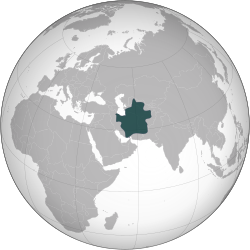
The Tahirids were a dynasty of Islamic Iranian rulers who governed Khorasan and much of the rest of Iran under the Abbasid caliphs. The Tahirids enjoyed considerable autonomy in practice but were not de jure independent;Template:SfnTemplate:SfnTemplate:Sfn Tahirid rulers fully acknowledged that they were subordinate viceroys, were always deferential to the caliphs, and regularly forwarded tribute to Baghdad.Template:Sfn The Tahirids were Arabized, but they were nevertheless Persians.[1] The Tahirids claimed descent from the Iranian mythological hero Rostam.Template:Sfn
As vassals of the Caliphate, the Tahirid rulers used the title amir.Template:Sfn The Tahirids initially ruled from Merv. The capital was transferred to Nishapur under Abdallah.Template:Sfn
| Portrait | Name | Reign | Succession |
|---|---|---|---|
| Tahir I | 821–822Template:Sfn (1 year) |
Granted governorship of Khorasan by Caliph al-Ma'mun for his service in the Fourth FitnaTemplate:Sfn | |
| Talha | 822–828Template:Sfn (6 years) |
Son of Tahir ITemplate:Sfn | |
| Template:Centre | Abdallah | 828–845Template:Sfn (17 years) |
Son of Tahir ITemplate:Sfn |
| Template:Centre | Tahir II | 845–862Template:Sfn (17 years) |
Son of AbdallahTemplate:Sfn |
| Template:Centre | Muhammad | 862–873Template:Sfn (11 years) |
Son of Tahir IITemplate:Sfn |
Saffarids (867–1002)
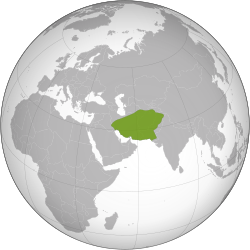
The Saffarids were a dynasty of Islamic Iranian rulers who at their height ruled much of Iran, and at times even reached into modern-day Iraq, from their base of power in Sistan.Template:Sfn Although the dynastic founder Ya'qub (867–879) claimed Sasanian descent,Template:Sfn the Saffarid dynasty originated as local ruffiansTemplate:Sfn and their power was attained solely through military might.Template:Sfn The Saffarid state expanded aggressively under the rule of Ya'qub and Amr I (879–901), under which the Tahirids were defeated and the Abbasid Caliphate was forced to confirm Saffarid control over various Iranian territories.Template:Sfn
Since they were nominally Abbasid subordinates, Saffarid rulers used the title amir.Template:Sfn Zaranj served as the Saffarid capital.Template:Sfn
| Portrait | Name | Reign | Succession |
|---|---|---|---|
| Ya'qub | 867–879Template:Sfn (12 years) |
Local ruffianTemplate:Sfn who established control over Sistan, Khorasan, and beyondTemplate:Sfn | |
| Amr I | 879–901Template:Sfn (22 years) |
Brother of Ya'qubTemplate:Sfn | |
| Template:Centre | Tahir | 901–909Template:Sfn (8 years) |
Grandson of Amr ITemplate:Sfn |
| Template:Centre | al-Layth | 909–910Template:Sfn (1 year) |
Nephew of Ya'qub and Amr ITemplate:Sfn |
| Template:Centre | Muhammad | 910–911Template:Sfn (1 year) |
Brother of al-LaythTemplate:Sfn |
| Template:Centre | al-Mu'addal | 911Template:Sfn (less than a year) |
Brother of al-LaythTemplate:Sfn |
| Template:Centre | Amr II | 912–913Template:Sfn (1 year) |
Great-grandson of Amr ITemplate:Sfn |
| Interregnum 913–923:Template:Sfn occupation by the Samanids.Template:Sfn | |||
| Ahmad | 923–963Template:Sfn (40 years) |
Married to a granddaughter of Amr ITemplate:Sfn | |
| Khalaf | 963–1002Template:Sfn (39 years) |
Son of AhmadTemplate:Sfn | |
Samanids (875–999)

The Samanids were a dynasty of Islamic Iranian rulers established by four brothers in 819, when they were granted four important cities and regions by the Abbasid Caliphate due to helping against the revolt of Rafi ibn al-Layth.Template:Sfn In 875, the Samanids increased dramatically in power through investment as governors of TransoxianaTemplate:SfnTemplate:Sfn and in 892, all Samanid-held territories were united under a single ruler (Ismail). Under Ismail, the Samanids became autonomous of the Abbasids.Template:Sfn The Samanids claimed descent from Bahram VI Chobin (589–590).Template:Sfn
Like other dynasties of their time, Samanid rulers used the title amir.Template:Sfn Mansur I (961/962–976/977) assumed the style šāhānšāh (Template:Literal translation) as a response to the use of that title by the Buyids.Template:Sfn Mansur I's son, Nuh II (976/977–997), also used šāhānšāh.Template:Sfn The Samanid capital was at Samarkand (875–892) and then at Bukhara.Template:Sfn
| Portrait | Name | Reign | Succession |
|---|---|---|---|
| Template:Centre | Nasr I | 875Template:Sfn – August/September 892Template:Sfn (17 years) |
Appointed governor of Transoxiana by the Abbasid Caliphate in 875Template:Sfn |
| Ismail | August/September 892 – 24 November 907Template:Sfn (15 years and 2–3 months) |
Brother of Nasr ITemplate:Sfn | |

|
Ahmad the Martyred Amir |
November/December 907 – 24 January 914Template:Sfn (6 years and 2–3 months) |
Son of IsmailTemplate:Sfn |
| Nasr II the Fortunate |
January 914 – March/April 943Template:Sfn (29 years and 2–3 months) |
Son of AhmadTemplate:Sfn | |
| Nuh I | April/May 943 – 954/955Template:Sfn (11–12 years) |
Son of Nasr IITemplate:Sfn | |
| Abd al-Malik I | 954/955–961/962Template:Sfn (8 years) |
Son of Nuh ITemplate:Sfn | |
| Mansur I the Righteous Amir |
961/962–976/977Template:Sfn (15 years) |
Son of Nuh ITemplate:Sfn | |
| Nuh II | 976/977 – 22 July 997Template:Sfn (10–11 years) |
Son of Mansur ITemplate:Sfn | |
| Mansur II | July/August 997 – 1 February 999Template:Sfn (1 year and 6–7 months) |
Son of Nuh IITemplate:Sfn | |
| Template:Centre | Abd al-Malik II | February 999Template:Sfn – 999Template:Sfn (less than a year) |
Son of Nuh IITemplate:Sfn |
| Portrait | Name | Tenure | Succession |
|---|---|---|---|
| Template:Centre | Ismail II Muntasir (Template:Literal translation) |
999Template:Sfn–1005Template:Sfn (6 years) |
Son of Nuh II.Template:Sfn Fought against the Kara-Khanid Khanate, which conquered Bukhara, for several years in an effort to restore the Samanids.Template:Sfn |
Ziyarids (927–1090/1091)
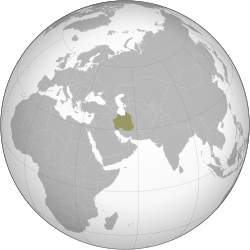
The Ziyarids were a dynasty of Iranian rulers established in northern Iran by Mardavij, a local mountain chief and mercenary who created an extensive kingdom in the late 920s and early 930s. Mardavij claimed descent from local pre-Islamic nobility and aspired to capture Baghdad, overthrow the Abbasids, and restore both the pre-651 empire as well as the Zoroastrian religion.Template:Sfn These aspirations came to an end with Mardavij's murder by his Turkic military slaves in 934/935.Template:Sfn Most of the Ziyarid realm was lost, except for territories surrounding the Caspian Sea, inherited by Mardavij's Islamic relatives.Template:Sfn
Mardavij may have revived the Sasanian ruling title šāhānšāh (Template:Literal translation) since later Buyid writers attribute the title to him.Template:SfnTemplate:Efn Later Ziyarid rulers used the title amir.Template:Sfn The Ziyarids went through a succession of capitals in northern Iran, including Ray, Amol, and Gorgan.Template:Sfn
| Portrait | Name | Reign | Succession |
|---|---|---|---|
| Mardavij | 927/928–934/935Template:Sfn (7 years) |
Mountain chief and mercenary who took control of much of northern IranTemplate:Sfn | |
| Template:Centre | Vushmgir | 934/935–966/967Template:Sfn (32 years) |
Brother of MardavijTemplate:Sfn |
| Bisutun | 966/967–977/978Template:Sfn (11 years) |
Son of VushmgirTemplate:Sfn | |
| Qabus | 977/978–1012/1013 (in exile 981–998)Template:Sfn (35 years) |
Son of VushmgirTemplate:Sfn | |
| Template:Centre | Manuchihr | 1012/1013–1029/1030Template:Sfn (17 years) |
Son of QabusTemplate:Sfn |
| Template:Centre | Anushirvan | 1029/1030–1049/1050Template:Sfn (20 years) |
Son of ManuchihrTemplate:Sfn |
| Template:Centre | Keikavus | 1049/1050–?Template:Sfn | Cousin of AnushirvanTemplate:Sfn |
| Template:Centre | Gilanshah | ?–1090/1091Template:Sfn | Son of KeikavusTemplate:Sfn |
Buyids (934–1062)
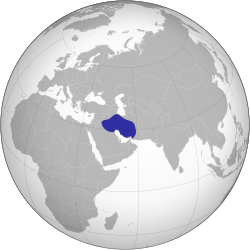
The Buyids were a dynasty of Islamic Iranian rulers established by three brothers who had served under Mardavij (the first Ziyarid ruler). After Mardavij's murder, the three carved out their own realm out of the southern Ziyarid territories.Template:Sfn The Buyid state was composed of three principalities ruled by three branches of the family, sometimes with divergent goals, rather than a unified realm.Template:Sfn The Buyids came to dominate much of Iran, a development that culminated in 945 with the capture of Baghdad and domination of the caliph himself.Template:Sfn The Buyid dynasty claimed descent from the Sasanian king Bahram V (420–438),Template:Sfn almost certainly a forgery.Template:Sfn
Individual Buyid rulers were styled as amir. The senior of the three was also invested by the caliph with the grander title amīr al-omarāʾ (Template:Literal translation).Template:Sfn The Buyid emirates were transformed into something akin to a restored Iranian monarchy under Rukn al-Dawla and his son 'Adud al-Dawla, who also reintroduced the Sasanian royal title šāhānšāh (Template:Literal translation).Template:Sfn This title continued to be sporadically claimed by Buyid dynasts.Template:Efn
This list records only the 'main branch' of Buyid rulers, per Daryaee (2012).Template:Sfn For a full list of major and minor Buyid rulers, see Buyid dynasty § Buyid rulers.
| Portrait | Name | Reign | Succession |
|---|---|---|---|
| Imad al-Dawla (Ali) |
933/934–949/950Template:Sfn (16 years, FarsTemplate:Sfn) |
Son of a Daylamite chief.Template:Sfn Seized power in the southern territories of the Ziyarid state.Template:Sfn | |
| Mu'izz al-Dawla (Ahmad) |
935/936–949/950Template:Sfn (14 years, KermanTemplate:Sfn then IraqTemplate:Sfn) |
Brother (and coregent) of Imad al-DawlaTemplate:Sfn | |

|
Rukn al-Dawla (Hasan) |
946/947 – 16 September 976Template:Sfn (29–30 years, RayTemplate:Sfn) |
Brother (and coregent) of Imad al-DawlaTemplate:Sfn |

|
'Adud al-Dawla (Panāh Khusraw) |
949/950 – 26 March 983Template:Sfn (33–34 years) |
Son of Rukn al-DawlaTemplate:Sfn |
| Sharaf al-Dawla (Shirdil) |
March/April 983 – September/October 989Template:Sfn (Template:Age in years, months and days) |
Son of 'Adud al-DawlaTemplate:Sfn | |
| Samsam al-Dawla (Abu Kalijar Marzuban) |
989–998Template:Sfn (9 years) |
Son of 'Adud al-DawlaTemplate:Sfn | |
| Baha al-Dawla (Abu Nasr Firuz) |
998–1012Template:Sfn (14 years) |
Son of 'Adud al-DawlaTemplate:Sfn | |
| Sultan al-Dawla (Abu Shuja) |
1012–1024Template:Sfn (12 years) |
Son of Baha al-DawlaTemplate:Sfn | |
| Abu Kalijar Marzuban | 1024–1048Template:Sfn (24 years) |
Son of Sultan al-DawlaTemplate:Sfn | |
| Template:Centre | Abu Mansur Fulad Sutun | 1048–1062Template:Sfn (14 years) |
Son of Abu Kalijar MarzubanTemplate:Sfn |

The Ghaznavids were of TurkicTemplate:SfnTemplate:Sfn slave origin.Template:Sfn In the tenth century, Turkish slave commanders became increasingly prominent, and eventually effectively autonomous, in the southern parts of the Samanid realm. In 977, the commander Sabuktigin seized power in Ghazni, nominally as a Samanid vassal. Once the Samanids went into terminal decline and collapsed in the late tenth century, Sabuktigin's state became a fully independent realm.Template:Sfn Although not Iranian, the Ghaznavid rulers nevertheless claimed descent from the Sasanian ruler Yazdegerd III (Template:Circa 633–651).Template:Sfn
Sabuktigin ruled with the title al-ḥājeb al-ajall (Template:Literal translation).Template:Sfn From 999 onwards,Template:Sfn the Ghaznavids ruled with the title sulṭān.Template:Sfn Sabuktigin's capital, Ghazni, remained the Ghaznavid capital for the duration of their rule in Iran.Template:Sfn
| Portrait | Name | Reign | Succession |
|---|---|---|---|
| Sabuktigin | 977/978–997/998Template:Sfn (20 years) |
Seized power in GhazniTemplate:Sfn | |
| Template:Centre | Ismail | 997/998–998Template:Sfn (less than a year) |
Son of SabuktiginTemplate:Sfn |
| Mahmud | 998 – 30 April 1030Template:Sfn (32 years) |
Son of SabuktiginTemplate:Sfn | |
| Muhammad | 1030Template:Sfn (briefly) |
Son of MahmudTemplate:Sfn | |
| Masʽud | 1030 – 23 May 1040Template:Sfn (10 years) |
Son of MahmudTemplate:Sfn |
The Ghaznavids lost their territories in Iran to the Seljuks after the Battle of Dandanaqan (1040).Template:SfnTemplate:Sfn For later Ghaznavid rulers, see Ghaznavids § List of rulers.
Turco-Mongol rule (1038–1508)
Seljuk Empire (1038–1194)
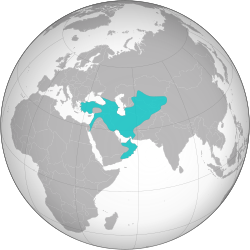
The Seljuk Empire was established by the Turkoman chieftain Tughril I, who invaded the Ghaznavids in the late 1030s.Template:Sfn In 1040, the Seljuks conquered the Ghaznavid-held parts of IranTemplate:SfnTemplate:Sfn and over the following decades they established control over most of the Middle East,Template:Sfn ending the Iranian Intermezzo.Template:Sfn Though they were not of Iranian origin, the Seljuk rulers bolstered their legitimacy by claiming descent from Afrasiab, a legendary figure from the Shahnameh.Template:Sfn
From the empire's inception, the Seljuk rulers minted coins with the title šāhānšāh (Template:Literal translation) in its Persian form,Template:Sfn perhaps adopting it from the Buyids.Template:Sfn Later on, the rulers more prominently used the Arabic title sulṭān and royal styles such as the Arabic malik and Persian šāh were bestowed on vassals.Template:Sfn Šāhānšāh continued to be used on the majority of Seljuk coinage, sometimes in the new variant "šāhānšāh king of Islam".Template:Sfn Nishapur served as the first capital of the Seljuk Empire. In 1143, the capital was moved to Ray and a few years later it was moved again to Isfahan. From 1118 onwards, the Seljuk regime became increasingle unstable and rival claimants used various bases of power, including Baghdad, Hamadan, and Merv.Template:Sfn
| Portrait | Name | Reign | Succession |
|---|---|---|---|
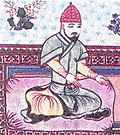
|
Tughril I | June/July 1038Template:Sfn – 4 September 1063Template:Sfn (25 years and 2–3 months) |
Initiated the Seljuk conquest of IranTemplate:Sfn |

|
Alp Arslan | 4 September 1063 – 15 December 1072Template:Sfn (Template:Age in years, months and days) |
Nephew of Tughril ITemplate:Sfn |

|
Malik-Shah I | 15 December 1072Template:Sfn – 14 October 1092Template:Sfn (Template:Age in years, months and days) |
Son of Alp ArslanTemplate:Sfn |
| Mahmud I | 14 October 1092Template:Sfn – 1093Template:Sfn (c. 1 year) |
Son of Malik-Shah ITemplate:Sfn | |

|
Berkyaruq | October/November 1092Template:Sfn – 22 December 1104Template:Sfn (12 years and 1–2 months) |
Son of Malik-Shah ITemplate:Sfn |
| Template:Centre | Malik-Shah II | 22 December 1104 – February/March 1105Template:Sfn (2–3 months) |
Son of BerkyaruqTemplate:Sfn |

|
Muhammad I Tapar | February/March 1105Template:Sfn – 5 August 1118Template:Sfn (13 years and 5–6 months) |
Son of Malik-Shah ITemplate:Sfn |
| Mahmud II | 5 August 1118Template:Sfn – 11 September 1131Template:Sfn (Template:Age in years, months and days) |
Son of Muhammad I Tapar.Template:Sfn Defeated by his uncle Ahmad Sanjar after eight months of rule, thereafter sultan only in Iraq.Template:Sfn | |

|
Ahmad Sanjar | 1118Template:Sfn – 8 May 1157Template:Sfn (39 years) |
Son of Malik-Shah I.Template:Sfn Previously Seljuk ruler in Khorasan.Template:Sfn |
| Template:Centre | Dawud | December 1132/January 1133Template:Sfn (briefly) |
Son of Mahmud II; sultan in IraqTemplate:Sfn |
| Template:Centre | Tughril II | December 1132/January 1133 – October/November 1134Template:Sfn (1 year and 10 months) |
Son of Muhammad I Tapar; sultan in IraqTemplate:Sfn |
| Template:Centre | Mas'ud | October/November 1134Template:Sfn – 10 October 1152Template:Sfn (18 years) |
Son of Muhammad I Tapar; sultan in IraqTemplate:Sfn |
| Template:Centre | Malik-Shah III | October 1152 – December 1152/January 1153Template:Sfn (2–3 months) |
Son of Mahmud II; sultan in IraqTemplate:Sfn |
| Template:Centre | Muhammad II | December 1152/January 1153Template:Sfn – December 1159/January 1160Template:Sfn (7 years) |
Son of Mahmud II; sultan in IraqTemplate:Sfn |
| Template:Centre | Suleiman-Shah | 22 MarchTemplate:Sfn – September/October 1160Template:Sfn (6–7 months) |
Son of Muhammad I Tapar; sultan in IraqTemplate:Sfn |
| Template:Centre | Arslan-Shah | September/October 1160Template:Sfn – January/February 1176Template:Sfn (15 years and 4 months) |
Son of Tughril II; sultan in IraqTemplate:Sfn |

|
Tughril III | January/February 1176Template:Sfn – 1194Template:Sfn (18 years) |
Son of Arslan-Shah; sultan in IraqTemplate:Sfn |
Khwarazmian Empire (1097–1220/1221)

The Seljuk Empire fractured after the death of Ahmad Sanjar in 1157 and its vassals became effectively independent.Template:Sfn One of these vassals was the Anushtegin dynasty, which ruled the Khwarazm region. The ruling dynasty were descendants of Anushtegin Gharchai, a former Turkic slave of the Seljuq sultans.Template:Sfn In 1194, the Khwarazmian ruler Tekish conquered western Iran and Iraq from the remnants of the Seljuk Empire.Template:Sfn
The Khwarazmian rulers used the ancient title xwârazmšāh, traditionally held by Iranian rulers of Khwarazm.Template:Sfn Urganj was the Khwarazmian capital.Template:Sfn
| Portrait | Name | Reign | Succession |
|---|---|---|---|
| Muhammad I | 1096/1097 – 1127/1128Template:Sfn (31 years) |
Seljuk vassal in KhwarazmTemplate:Sfn | |
| Atsiz | 1127/1128 – 30 July 1156Template:Sfn (28–29 years) |
Son of Muhammad I. Seljuk vassal.Template:Sfn | |

|
Il-Arslan | 22 August 1156 – March 1172Template:Sfn (15 years and 7 months) |
Son of AtsizTemplate:Sfn |
| Template:Centre | Sultan Shah | 1172 – 11 December 1172Template:Sfn (less than a year) |
Son of Il-Arslan.Template:Sfn Deposed by Tekish, who he continued to oppose as a rival claimant until 1193.Template:Sfn |
| Template:Centre | Tekish | 11 December 1172 – 3 July 1200Template:Sfn (Template:Age in years, months and days) |
Son of Il-Arslan.Template:Sfn Conquered western Iran and Iraq from the remnants of the Seljuk Empire in 1194.Template:Sfn |

|
Muhammad II | 3 August 1200 – 1220/1221Template:Sfn (20–21 years) |
Son of TekishTemplate:Sfn |
| Portrait | Name | Tenure | Succession |
|---|---|---|---|
| Mangburni | 1220/1221 – August 1231Template:Sfn (10–11 years) |
Son of Muhammad II.Template:Sfn Fled to India for three years (1221–1224) after the Mongol conquest of the Khwarazmian Empire and was then involved in various wars in western Iran.Template:Sfn |
Mongol Empire (1220–1259)

The Mongol Empire was established by Genghis Khan in 1206 through uniting the Mongol clans.Template:Sfn The unification of the clans was followed by aggressive imperial expansion throughout Asia and parts of Europe.Template:Sfn In the early thirteenth century, the Mongols under reached Iran. The region around Bukhara was conquered in 1220Template:Sfn and the Khwarazmian Empire was destroyed.Template:Sfn Over the following decades, further conquests followed in the Middle East, culminating in the fall of Baghdad and end of the Abbasid Caliphate's rule there in 1258.Template:Sfn
The rulers of the Mongol Empire used the ruling title khagan (Template:Literal translation).Template:Sfn In the 1230s, the Mongol Empire established its capital at Karakorum in Mongolia.Template:Sfn
| Portrait | Name | Reign | Succession |
|---|---|---|---|
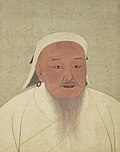
|
Genghis Khan | 1220Template:Sfn – 25 August 1227Template:Sfn (7 years) |
Founder of the Mongol Empire.Template:Sfn Conquered the region around Bukhara in 1220, initiating Mongol rule in Iran.Template:Sfn |
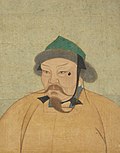
|
Ögedei Khan | 13 September 1229Template:Sfn – 11 December 1241Template:Sfn (Template:Age in years, months and days) |
Son of GenghisTemplate:Sfn |

|
Güyük Khan | 24 August 1246 – April 1248Template:Sfn (1 year and 8 months) |
Son of ÖgedeiTemplate:Sfn |

|
Möngke Khan | 2 May 1252Template:Sfn – 11 August 1259Template:Sfn (Template:Age in years, months and days) |
Grandson of GenghisTemplate:Sfn |
Ilkhanate (1256–1388)

After the death of Möngke Khan, the Mongol Empire was fractured by civil war, both over the succession of the next Great Khan and between nomadic traditionalists and the new settled princes of China and the Middle East. Kublai Khan (1260–1294) was eventually universally recognized but the empire was irreversibly fragmented.Template:Sfn In much of the south-west of the empire (including Iran), power fell to Hulegu Khan,Template:Sfn who had been made a deputy there under Möngke Khan.Template:Sfn Hulegu was swiftly accepted as a legitimate ruler in Iran and was further legitimized through a fatwa issued by the Shia scholar Ali ibn Tawus al-Hilli.Template:Sfn Iran experienced a cultural renaissance under Ilkhanid rule.Template:Sfn Ghazan Khan (1295–1304) converted to Islam in the late thirteenth century, turning the state further away from the other Mongol realms.Template:Sfn
The rulers of the Ilkhanate adopted the style ilkhan (Template:Literal translation) to show deference to the Great Khan in China and Mongolia.Template:Sfn From the time of Ghazan Khan onwards, they also used the title pādishāh-i Īrān (Template:Literal translation), sometimes extended to pādishāh-i Īrān wa Islām (Template:Literal translation).Template:Sfn The version pādishāh-i Islām (Template:Literal translation) is also recorded.Template:Sfn The Ilkhanate went through a succession of capitals, beginning with Maragheh (1256–1265), Tabriz (1265–1306), and Soltaniyeh (1306–1335).Template:Sfn After the empire disintegrated in the 1330s, various claimants established different centers of power. The last ilkhan, Luqman, ruled from Astarabad under Timurid suzerainty.Template:Sfn
| Portrait | Name | Reign | Succession |
|---|---|---|---|

|
Hulegu Khan | 1256Template:Sfn – 8 February 1265Template:Sfn (9 years) |
Grandson of Genghis Khan.Template:Sfn Granted power in Iran under Möngke Khan.Template:Sfn |

|
Abaqa Khan | 8 February 1265Template:Sfn – 1 April 1282Template:SfnTemplate:Sfn (Template:Age in years, months and days) |
Son of HuleguTemplate:Sfn |

|
Ahmad Tekuder | 1 April 1282Template:Sfn – 10 August 1284Template:Sfn (Template:Age in years, months and days) |
Son of HuleguTemplate:Sfn |

|
Arghun Khan | 11 August 1284 – 10 March 1291Template:Sfn (Template:Age in years, months and days) |
Son of AbaqaTemplate:Sfn |
| Gaykhatu | 10 March 1291 – 26 March 1295Template:Sfn (Template:Age in years, months and days) |
Son of AbaqaTemplate:Sfn | |
| Baydu | 26 March – summer? 1295Template:Sfn (a few months) |
Grandson of HuleguTemplate:Sfn | |

|
Ghazan Khan | Summer? 1295 – 11 May 1304Template:Sfn (9 years) |
Son of ArghunTemplate:Sfn |

|
Öljaitü | 11 May 1304 – 16 December 1316Template:Sfn (Template:Age in years, months and days) |
Son of ArghunTemplate:Sfn |

|
Abu Sa'id Bahadur Khan | 16 December 1316Template:Sfn – 30 November 1335Template:Sfn (Template:Age in years, months and days) |
Son of ÖljaitüTemplate:Sfn |
| Musa Khan | 1335/1336–1336Template:Sfn (less than a year) |
Grandson of BayduTemplate:Sfn | |
| Arpa Khan | 1335–1336Template:Sfn (1 year) |
Descendant of Tolui, the father of HuleguTemplate:Sfn | |
| Muhammad Khan | 1336–1338Template:Sfn (2 years) |
Great-great-great-grandson of HuleguTemplate:Sfn | |
| Togha Temür | 1337–1353 (6 years) |
Descendant of Qasar, a brother of Genghis KhanTemplate:Sfn | |
| Template:Centre | Jahan Temür | 1338/1339–1340/1341Template:Sfn (2 years) |
Grandson of GaykhatuTemplate:Sfn |
| Template:Centre | Sati Beg | 1338/1339–1339/1340Template:Sfn (1 year) |
Daughter of Öljaitü.Template:Sfn Fourth and last of only four women to rule in Iranian history.Template:Efn |
| Template:Centre | Suleiman Khan | 1339/1340 – 1343/1344Template:Sfn (4 years) |
Great-great-grandson of HuleguTemplate:Sfn |
| Anushirwan Khan | 1344–1356Template:Sfn (12 years) |
Unknown lineageTemplate:Sfn | |
| Template:Centre | Ghazan II | 1356–1357Template:Sfn (1 year) |
Son of Togha TemürTemplate:Sfn |
| Template:Centre | Luqman | 1356Template:Sfn–1388Template:Sfn (32 years) |
Son of Togha Temür.Template:Sfn Puppet ruler under various warlords, including Amir ValiTemplate:Sfn and later Timur.Template:Sfn |
Timurid Empire (1370–1458)

The Timurid Empire was established by Timur, a conqueror who claimed both Turkic and Mongol descent. Timur began as a minor brigand chief under the Chagatai Khanate.Template:Sfn In the middle 1360s, Timur rose to become the effective ruler of Transoxiana. He went on to establish his seat of power in Khorasan and conquered most of Iran through campaigns in the 1380s and 1390s.Template:Sfn
During his conquests, Timur made some effort to portray himself as the heir of the Ilkhanate, adopting the Ilkhanid title pādishāh-i Islām (Template:Literal translation).Template:Sfn Timur also used the style guregen (Template:Literal translation) to stress his marriage to Saray Mulk Khanum, a descendant of Genghis Khan.Template:Sfn Pādishāh continued to be used by Timur's successors, who at times also adopted the style of sulṭān.Template:Sfn Samarkand was the capital of the Timurid Empire.Template:Sfn
| Portrait | Name | Reign | Succession |
|---|---|---|---|

|
Timur | 9 April 1370 – 18 February 1405Template:Sfn (Template:Age in years, months and days) |
Conquered Iran in the 1370s–1390s.Template:Sfn |
| Template:Centre | Pir Muhammad | February 1405 – 1407Template:Sfn (2 years) |
Grandson of TimurTemplate:Sfn and his designated heir.Template:Sfn Ruler in Fars.Template:Sfn |

|
Khalil Sultan | February 1405Template:Sfn – 1409/1410Template:Sfn (4–5 years) |
Grandson of Timur.Template:Sfn Senior Timurid ruler and ruler of Persia.Template:Sfn |

|
Shah Rukh | February 1405Template:Sfn – 1446/1447Template:Sfn (41–42 years) |
Son of Timur. Initially only ruler in Khorasan; ruler of the entire empire from 1415/1416 onwards.Template:Sfn |

|
Ulugh Beg | 1446/1447 – October/November 1449Template:Sfn (2–3 years) |
Son of Shah RukhTemplate:Sfn |
| Template:Centre | Abdal-Latif Mirza | October/November 1449 – May 1450Template:Sfn (6–7 months) |
Son of Ulugh BegTemplate:Sfn |

|
Abdullah Mirza | May 1450 – 1451/1452Template:Sfn (1–2 years) |
Grandson of Shah RukhTemplate:Sfn |

|
Abu Sa'id Mirza | 1451/1452Template:Sfn–1458Template:Sfn (6–7 years) |
Great-grandson of TimurTemplate:Sfn |
The Timurids lost almost all of their territories in Iran to the Qara Qoyunlu in 1452–1458.Template:Sfn For later Timurid rulers in Khorasan and elsewhere, see Timurid Empire § Emperors (Emir).
Qara Qoyunlu (1452–1469)

The Qara Qoyunlu were a semi-nomadic Turkoman confederation that grew in power west of Iran following the collapse of the Ilkhanate. The origins of the Qara Qoyunlu are obscure and they are first recorded as an identifiable group in the 1330s.Template:Sfn Under the leader Jahan Shah, the Qara Qoyunlu seized most of Iran from the Timurids. This began with the conquest of Jibal in 1452, and continued with further conquests of Isfahan, Fars, and Kerman in 1458.Template:Sfn
The Qara Qoyunlu rulers presented themselves as rulers of Iran and political successors of the Ilkhanate, using titles such as pādishāh-i Īrān (Template:Literal translation) and kesra-yi Īrān (Template:Literal translation).Template:Sfn Tabriz served as the Qara Qoyunlu capital 1436–1467.Template:Sfn
This list only includes the Qara Qoyunlu rulers who ruled Iran.Template:Sfn For a full list, see the list of rulers of Qara Qoyunlu.
| Portrait | Name | Reign | Succession |
|---|---|---|---|
| Jahan Shah | 1452–1467Template:Sfn (15 years) |
Conquered much of Iran from the Timurid Empire in 1452–1458Template:Sfn | |
| Hasan Ali | 1467–1469Template:Sfn (2 years) |
Son of Jahan ShahTemplate:Sfn |
Aq Qoyunlu (1465–1508)

Like the Qara Qoyunlu, the Aq Qoyunlu were a semi-nomadic Turkoman confederation that rose to power after the Ilkhanate's collapse. The Aq Qoyunlu was a more long-lived and better recorded group.Template:Sfn In the 1450s and 1460s, the Aq Qoyunlu under Uzun Hasan defeated both the Qara Qoyunlu and Timurid forces and by 1469, Uzun Hasan ruled all of Iraq and Iran.Template:Sfn
Like the preceding Qara Qoyunlu, the Aq Qoyunlu rulers titled themselves as pādishāh-i Īrān (Template:Literal translation) and kesra-yi Īrān (Template:Literal translation), among other titles.Template:Sfn Amida was the original Aq Qoyunlu capital.Template:Sfn The capital was transferred to Tabriz under Uzun Hasan.Template:Sfn
This list only includes the Aq Qoyunlu rulers who ruled Iran.Template:Sfn For a full list, see the list of rulers of Aq Qoyunlu.
| Portrait | Name | Reign | Succession |
|---|---|---|---|

|
Uzun Hasan | 1465/1469–1478Template:Sfn (9–13 years) |
Conquered Iran in the 1460sTemplate:Sfn |

|
Sultan-Khalil | 1478Template:Sfn (less than a year) |
Son of Uzun HasanTemplate:Sfn |

|
Yaqub | 1478–1490Template:Sfn (12 years) |
Son of Uzun HasanTemplate:Sfn |
| Baysunghur | 1490–1492Template:Sfn (2 years) |
Son of YaqubTemplate:Sfn | |

|
Rustam Beg | 1492–1496Template:Sfn (4 years) |
Grandson of Uzun HasanTemplate:Sfn |

|
Ahmad Beg | 1496–1497Template:Sfn (1 year) |
Grandson of Uzun HasanTemplate:Sfn |
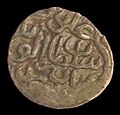
|
Alvand Beg | 1497–1502Template:Sfn (5 years, in Diyar Bakr and then Azerbaijan) |
Grandson of Uzun HasanTemplate:Sfn |
| Template:Centre | Muhammad Beg | 1499–1500Template:Sfn (1 year, in Iraq and southern Persia) |
Grandson of Uzun HasanTemplate:Sfn |

|
Sultan Murad | 1500–1508Template:Sfn (8 years, in Fars and Kerman) |
Son of YaqubTemplate:Sfn |
| Template:Centre | Zayn al-Abidin | 1504–1508Template:Sfn (4 years, in Diyar Bakr) |
Great-grandson of Uzun HasanTemplate:Sfn |
Minor kingdoms and dynasties
- Various local Iranian dynasties in Tabaristan:
- Qarinvand dynasty (550s–11th century)
- Dabuyid dynasty (642–760)
- Bavand dynasty (651–1349)
- Baduspanid dynasty (665–1598)
- Afrasiyab dynasty (1349–1504)
- Ghurid dynasty (786–1215), which controlled parts of eastern Iran
- Minor dynasties of the Iranian Intermezzo:
- Sajid dynasty (889–929) in north-western Iran and Azerbaijan
- Rawadid dynasty (900–1070/1116) in Azerbaijan
- Sallarid dynasty (919–1062) in north-western Iran and Azerbaijan
- The Ilyasids (932–968) in Kerman
- The Shaddadids (951–1199) in Armenia
- The Hasanwayhids (959–1015) in north-western Iran and Azerbaijan
- The Marwanids (983/990–1084) in Mesopotamia
- The Annazids (990/991–late 12th century) in western Iran/eastern Iraq
- The Kakuyids (1008–1141) in central Iran
- Minor successor states of the Ilkhanate:
- Kart dynasty (1244–1381) in much of Khorasan
- The Muzaffarids (1314–1393) in central and southern Iran
- The Injuids (1335–1357) in southern Iran
- Jalayirid Sultanate (1335–1432) in Iraq and western Iran
- The Sarbadars (1337–1381) in parts of Khorasan
- The Chobanids (1338–1357) in north-western Iran and Azerbaijan
Modern Iran (1501–1979)
Safavid Iran (1501–1722)
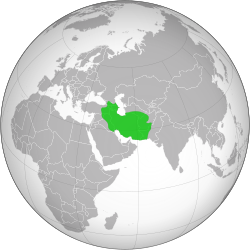
Of native Iranian (possibly Kurdish) origins,[2] the Safavid dynasty originated as the leaders of the medieval mystic Safavid order. In 1499, the Safavid sheikh Ismail defeated the Shirvanshahs of Azerbaijan and began to wrest control of Iran from the Aq Qoyunlu. The power of the Aq Qoyunlu was decisively broken in 1501 with the defeat of Alvand Beg.Template:Sfn In 1502, Ismail crowned himself šâhanšâh at Tabriz.Template:Sfn The rise of the Safavids is often considered the beginning of modern Iranian history, with their state being the earliest stage of the modern Iranian nation state.Template:SfnTemplate:Sfn Through further conquests, the Safavids restored Iran as a single Iranian political unit and retransformed the tribal nomadic order of the land, established during its period under Turko-Mongol rule, into a sedentary society. Shia Islam was for the first time established as the state religion.Template:Sfn
The Safavids ruled as šâhanšâh-e Irân (Template:Literal translation).Template:Sfn The initial capital of the Safavid Empire was at Tabriz. Due to conflict with the Ottoman Empire in the west, the capital was moved eastwards to Qazvin in 1548, and then to Isfahan in the 1590s.Template:Sfn
Intermediate period (1722–1796)
Complex rivalries in the region of Khorasan led to the Afghan Hotak dynasty invading Iran. In 1722, this conflict led to the collapse of the Safavid Empire after the siege of Isfahan.Template:SfnTemplate:Sfn The brief interlude between 1722 and the rise of the Qajar dynasty in 1789–1796 was marked by widespread political turmoil in Iran and several rival attempts to establish power over the country. The Safavids failed to regain power and the Hotaks failed to establish control. The rival Afsharid and Zand dynasties were established by Nader Shah (1736–1747) and Karim Khan (1751–1779), respectively. Although both of these founding figures established their rule over large parts of the former Safavid domain, the political influence of their dynasties swiftly collapsed under their successors.Template:Sfn
Hotaks (1722–1729)
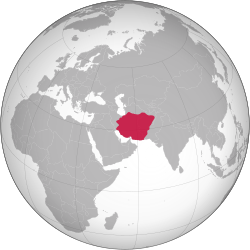
In 1701, unrest among the Ghilji Pashtun tribe of Afghanistan led to a rebellion against the Safavids. This uprising was suppressed by the local commander, George XI of Kartli, but the Afghan anti-Safavid movement continued under Mirwais Hotak and his son, Mahmud Hotak. Mahmud initially feigned loyalty and was officially appointed as governor of Kandahar. In 1720, he began raiding the Kerman area and in March 1722, a larger hastily assembled and more powerful Safavid army was defeated at the Battle of Gulnabad. Following a six-month siege of Isfahan, Soltan Hoseyn I formally submitted to Mahmud and recognized him as the new shah of Iran.Template:Sfn The Hotak rulers of Iran ruled from the former Safavid capital of Isfahan.Template:Sfn
| Portrait | Name | Reign | Succession |
|---|---|---|---|

|
Mahmud Hotak | 22 October 1722 – April/May 1725Template:Sfn (Template:Age in years, months and days) |
Invaded and seized power from Soltan Hoseyn ITemplate:Sfn |

|
Ashraf Hotak | April/May 1725 – 1729Template:Sfn (4 years) |
Cousin of Mahmud Hotak; murdered and overthrew MahmudTemplate:Sfn |
Safavid dynasts (1722–1773)
When news of the fall of Isfahan reached Soltan Hoseyn I's son Tahmasp II at Qazvin, Tahmasp proclaimed himself shah.Template:Sfn Pro-Safavid forces successfully defeated Ashraf Hotak in 1729 and forced to Afghan forces out of Iran.Template:Sfn Tahmasp failed to assert his authority in the aftermath of the Hotak invasion and the effective ruler of Iran was instead the general Nader Khan. In 1732, Nader deposed Tahmasp and replaced him with the eight-month old Abbas III. Abbas was in turn deposed in 1736 and Nader Khan was proclaimed the new shah of Iran under the name Nader Shah, terminating the Safavid dynasty.Template:Sfn Safavid descendants continued to emerge for some time after 1736 as pretenders or as figurehead rulers put forward by warlords vying for power in Iran.Template:Sfn
| Portrait | Name | Reign | Succession |
|---|---|---|---|

|
Tahmasp II | 31 October 1722Template:Sfn – August 1732Template:Sfn (Template:Age in years, months and days) |
Son of Soltan Hoseyn ITemplate:Sfn |

|
Abbas III | 7 September 1732 – 8 March 1736Template:Sfn (Template:Age in years, months and days) |
Son of Tahmasp IITemplate:Sfn |
| No recognized Safavid ruler 1736–1750 | |||
| Suleiman II | 13 January – March 1750Template:Sfn (2 months) |
Grandson of Suleiman I.Template:Sfn Proclaimed shah at Mashhad after the deposition of Shahrokh Shah (Afsharid) and ruled until Shahrokh was restored.Template:Sfn | |

|
Ismail III | Summer 1750 – 1773Template:Sfn (23 years) |
Grandson of Soltan Hoseyn I. Proclaimed shah at Isfahan by Karim Khan Zand in 1750, as a puppet ruler.Template:Sfn |
| Template:Centre | Soltan Hoseyn II | 1752Template:Sfn/1753Template:Sfn | Son of an Azeri man and an Armenian woman, but claimed to be a son of Tahmasp II.Template:Sfn Proclaimed shah at Baghdad by Ali Mardan Khan Bakhtiari, as a puppet ruler.Template:Sfn |
Afsharids (1736–1796)

The Afsharid dynasty was established by Nader Shah, a general under the Safavids who seized control of the empire in 1736 after the deposition of Abbas III.Template:Sfn Nader was a powerful conqueror but the Afsharid Empire quickly collapsed after his assassination in 1747. Large territories fell to the rival Zand dynasty as well as the Afghan Durrani Empire. The domain of Nader's heirs became largely confined to the Iranian parts of Khorasan. For most of its later history, the Afsharid state was dominated by military leaders or other court factions.Template:Sfn The Afsharids ruled with the style of šâhanšâhTemplate:Sfn and their capital was at Mashhad.Template:Sfn
| Portrait | Name | Reign | Succession |
|---|---|---|---|

|
Nader Shah | 8 March 1736 – 20 June 1747Template:Sfn (Template:Age in years, months and days) |
General; deposed Abbas IIITemplate:Sfn |

|
Adel Shah | 6 July 1747Template:Sfn – 24 September 1748Template:Sfn (Template:Age in years, months and days) |
Nephew of Nader Shah; proclaimed ruler after Nader's assassinationTemplate:Sfn |

|
Shahrokh Shah | 1 October 1748Template:Sfn – 13 January 1750Template:Sfn (1st reign) (Template:Age in years, months and days) |
Grandson of Nader Shah and matrilineal grandson of Soltan Hoseyn I (Safavid). Proclaimed ruler by tribal leaders at Mashhad in opposition to Adel.Template:Sfn |

|
Ebrahim Shah | 8 December 1748 – December 1749Template:Sfn (~1 year) |
Brother of Adel Shah; proclaimed ruler (in opposition to Shahrokh Shah) after deposing and blinding AdelTemplate:Sfn |
| Shahrokh Shah was removed from the throne in January–March 1750 in favor of the Safavid ruler Suleiman IITemplate:Sfn | |||

|
Shahrokh Shah | March 1750Template:Sfn – 1796Template:Sfn (2nd reign) (46 years) |
Restored to the throneTemplate:Sfn |
Zands (1751–1794)

In the aftermath of Nader Shah's assassination, the Zand family grew to become the most powerful rivals of the Afsharids and seized control of much of Iran in the 1750s.Template:Sfn Established by the tribal leader Karim Khan Zand, the Zand rulers never proclaimed themselves to be shahs.Template:SfnTemplate:Sfn Instead, they presented themselves as regents of Iran, at first on behalf of the Safavid puppet Ismail III (1750–1773) and then on behalf of the Iranian people.Template:SfnTemplate:Sfn Karim Khan Zand ruled with the title of khân, as well as the style of wakil (regent) or wakil-al-raʿāyāʾ (Template:Literal translation).Template:Sfn His successors ruled simply as khân, though were often considered to be "kings" by European observers.Template:Sfn The Zand dynasty ruled from Shiraz.Template:Sfn
| Portrait | Name | Reign | Succession |
|---|---|---|---|

|
Karim Khan | 1751 – 1 March 1779Template:Sfn (28 years) |
Seized power over much of IranTemplate:Sfn |
| Template:Centre | Mohammad-Ali Khan | 2 March – 19 June 1779Template:Sfn (Template:Age in years, months and days) |
Son of Karim Khan.Template:Sfn Joint co-ruler with his brother Abol-Fath Khan.Template:Sfn |
| Template:Centre | Abol-Fath Khan | 2 March – 22 August 1779Template:Sfn (Template:Age in years, months and days) |
Son of Karim Khan.Template:Sfn Initially joint co-ruler with his brother Mohammad-Ali Khan.Template:Sfn |

|
Sadeq Khan | 22 August 1779 – 14 March 1781Template:Sfn (Template:Age in years, months and days) |
Brother of Karim KhanTemplate:Sfn |
| Template:Centre | Ali-Morad Khan | 14 March 1781 – 10 January 1785Template:Sfn (Template:Age in years, months and days) |
Member of the 'Hazāra' branch of the Zand familyTemplate:Sfn |

|
Jafar Khan | 17 January 1785 – 23 January 1789Template:Sfn (Template:Age in years, months and days) |
Son of Sadeq KhanTemplate:Sfn |
| Template:Centre | Sayed Morad Khan | 23 January – 7 May 1789Template:Sfn (Template:Age in years, months and days) |
Cousin of Ali-Morad Khan. Mutinied against Jafar Khan (leading to Jafar's death) and opposed the accession of Jafar's son, Lotf Ali Khan.Template:Sfn |
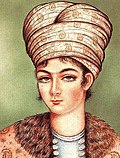
|
Lotf Ali Khan | 7 May 1789Template:Sfn – November 1794Template:Sfn (Template:Age in years, months and days) |
Son of Jafar Khan.Template:Sfn |
Qajar Iran (1789–1925)

The Qajar dynasty originated as a local TurkomanTemplate:Sfn noble family in northern Iran, under the Safavids.Template:Sfn The Qajars gradually increased in power as other families fought each other in Iran, culminating in Agha Mohammad Shah proclaiming himself ruler in 1789, in opposition to the Afsharids and Zands.Template:Sfn Agha Mohammad defeated the Zand dynasty in 1794Template:Sfn and was officially crowned in 1796.Template:Sfn Shortly thereafter, he captured and deposed the Afsharid Shahrokh Shah, reunifying Iran under a single ruler.Template:Sfn
Agha Mohammad Shah ruled with the title khân and later šâh, never assuming the more grandiose šâhanšâh.Template:Sfn Agha Mohammad's successor, Fath-Ali Shah, assumed both šâhanšâh and the Mongol khagan,Template:Sfn titles frequently used by later Qajar rulers.Template:Sfn Many other honorifics of imperial and religious significance were also used by the Qajar rulers.Template:Sfn The Qajar dynasty ruled from Tehran, inaugurated as Iran's capital in the 1780s under Agha Mohammad Shah.Template:Sfn
| Portrait | Name | Reign | Succession |
|---|---|---|---|

|
Agha Mohammad Khan | 1789Template:Sfn – 17 June 1797Template:Sfn (8 years) |
Seized power and reunified Iran 1789–1796Template:Sfn |

|
Fath-Ali Shah | 17 June 1797 – 23 October 1834Template:Sfn (Template:Age in years, months and days) |
Nephew of Agha Mohammad ShahTemplate:Sfn |

|
Mohammad Shah | 23 October 1834 – 5 September 1848Template:Sfn (Template:Age in years, months and days) |
Grandson of Fath-Ali ShahTemplate:Sfn |

|
Naser al-Din Shah | 5 September 1848 – 1 May 1896Template:Sfn (Template:Age in years, months and days) |
Son of Mohammad ShahTemplate:Sfn |

|
Mozaffar ad-Din Shah | 1 May 1896 – 3 January 1907Template:Sfn (Template:Age in years, months and days) |
Son of Naser al-Din ShahTemplate:Sfn |

|
Mohammad Ali Shah | 3 January 1907 – 16 July 1909Template:Sfn (Template:Age in years, months and days) |
Son of Mozaffar ad-Din ShahTemplate:Sfn |

|
Ahmad Shah | 16 July 1909 – 15 December 1925Template:Sfn (Template:Age in years, months and days) |
Son of Mohammad Ali ShahTemplate:Sfn |
| Portrait | Name | Tenure | Succession |
|---|---|---|---|

|
Ahmad Shah | 15 December 1925Template:Sfn – 27 February 1930Template:Sfn (Template:Age in years, months and days) |
Ruler of Iran 1909–1925. Died in exile in France.Template:Sfn |
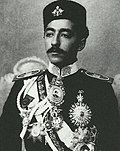
|
Mohammad Hassan Mirza | 27 February 1930Template:Sfn – 7 January 1943Template:Sfn (Template:Age in years, months and days) |
Son of Mohammad Ali Shah and designated successor of Ahmad Shah (his brother).Template:Sfn |

|
Hamid Mirza | No formal claim put forth | Son of Mohammad Hassan Mirza. Viewed himself as the rightful heir after his father's death but did not officially claim the throne.Template:Sfn Was monitored by the US Department of State in 1943 over whether he would declare himself Shah of Iran.Template:Sfn |

|
Fereydoun Mirza | No formal claim put forth | Son of Ahmad Shah. While he lived in Switzerland in 1943, the US Department of State intercepted and suppressed messages from relatives urging Fereydoun to declare himself the rightful Shah of Iran.Template:Sfn |
| There continues to be recognized heads of the Qajar family in exile to the present day, though the family has renounced all claims to rule through lineage and does not endorse political activity under its coat of arms.[3]Template:Better source needed | |||
Pahlavi Iran (1925–1979)
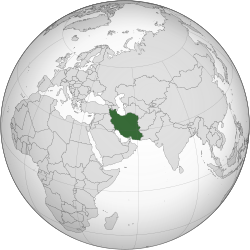
During the late Qajar dynasty, Iran became increasingly embroiled in internal political turmoil over the extent of the monarch's power, among other events leading to the Persian Constitutional Revolution (1905–1911). In 1923, the brigade commander Reza Khan quickly rose through the ranks to become prime minister.Template:Sfn In 1925, Reza succeeded in deposing Ahmad Shah and having himself proclaimed by Iran's National Assembly first as regent and then as the new monarch.Template:Sfn As his family name, Reza took Pahlavi, after the Pahlavi language of the pre-Islamic Sasanian Empire.Template:Sfn
The Pahlavi rulers styled themselves as šâhanšâh-e Irân (Template:Literal translation).Template:SfnTemplate:Sfn Tehran remained the capital of Iran under Pahlavi rule.Template:Sfn
| Portrait | Name | Reign | Succession |
|---|---|---|---|
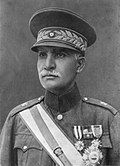
|
Reza Shah | 15 December 1925 – 16 September 1941Template:Sfn (Template:Age in years, months and days) |
Former prime ministerTemplate:Sfn |

|
Mohammad Reza Shah | 16 September 1941 – 11 February 1979Template:Sfn (Template:Age in years, months and days) |
Son of Reza ShahTemplate:Sfn |
| Portrait | Name | Tenure | Succession |
|---|---|---|---|

|
Mohammad Reza Shah | 11 February 1979Template:Sfn – 27 July 1980Template:Sfn (Template:Age in years, months and days) |
Ruler of Iran 1941–1979. Died in exile in Egypt.Template:Sfn |

|
Farah Pahlavi | 27 July – 31 October 1980 (Template:Age in years, months and days) |
As regent |

|
Reza Pahlavi ("Reza Shah II"Template:Sfn) |
31 October 1980Template:Sfn – present (Template:Age in years, months and days) |
Son of Mohammad Reza Shah. Proclaimed himself "Reza Shah II", rightful ruler of Iran, in October 1980.Template:Sfn Has voiced support for democracy but has not renounced his claim to the throne.Template:Sfn |
See also
- History of Iran – a general overview of Iranian history
- Monarchism in Iran – advocacy for restoring the Iranian monarchy
- List of royal consorts of Iran – the consorts of the rulers of Iran
- Pishdadian dynasty and Kayanian dynasty – two legendary Iranian dynasties from the Avesta and the Shahnameh
- List of rulers of the pre-Achaemenid kingdoms of Iran – poorly attested regional rulers before the Achaemenid Empire
Notes
References
Citations
- ↑
- Template:Harvnb: "The Ṭāhirids were culturally highly Arabicized, but they were nevertheless Persians. The firm and generally just rule which they gave to the eastern Iranian world favoured a material and cultural progress, whereas earlier, the indigenous, older Iranian culture had been weakened by the dynamic impact of Islamic religion and Arab political dominance."
- Template:Harvnb: "The Taherids were thoroughly Arabicized and remained loyal to the caliphate, but the fact that they were of Persian extraction and were ruling in Persian territory made a start for dynasties in Persia enjoying local autonomy."
- ↑
- Template:Harvnb: "Despite recent research, the origins of the Safavid family are still obscure. Such evidence as we have seems to suggest that the family hailed from Kurdistān. What does seem certain is that the Safavids were of native Iranian stock, and spoke Āzarī, the form of Turkish used in Āzarbāyjān. Our lack of reliable information derives from the fact that the Safavids, after the establishment of the Safavid state, deliberately falsified the evidence of their own origins."
- Template:Harvnb: "Of Kurdish ancestry, the Ṣafavids started as a Sunnī mystical order (...)"
- Template:Harvnb: "The Safavids, as Iranians of Kurdish ancestry and of nontribal background, did not fit this pattern, although the stat they set up with the aid of Turkmen tribal forces of Eastern Anatolia closely resembled this division in its makeup. Yet, the Turk versus Tajik division was not impregnable."
- Template:Harvnb: "As Persians of Kurdish ancestry and of a non-tribal background, the Safavids did not fit this pattern, though the state they set up with the assistance of Turkmen tribal forces of eastern Anatolia closely resembled this division in its makeup."
- Template:Harvnb: "This official version contains textual changes designed to obscure the Kurdish origins of the Safavid family and to vindicate their claim to descent from the Imams."
- Template:Harvnb: "The Safavids originated as a hereditary lineage of Sufi shaikhs centered on Ardabil, Shafeʿite in school and probably Kurdish in origin."
- Template:Harvnb "The Safavi house originally was among the landowning nobility of Kurdish origin, with affinity to the Ahl-e Haqq in Kurdistan (chart 1). In the twelfth century, the family settled in northeastern Azarbaijan, where Safi al-Din Ardabili (d. 1334), the patriarch of the Safavid house and Ismail's ancestor dating back six generations, was a revered Sufi leader."
- Template:Harvnb: "The Safavid Shahs who ruled Iran between 1501 and 1722 descended from Sheikh Safi ad-Din of Ardabil (1252–1334). Sheikh Safi and his immediate successors were renowned as holy ascetics Sufis. Their own origins were obscure; probably of Kurdish or Iranian extraction, they later claimed descent from the Prophet."
- Template:Harvnb: "The Safavid dynasty was of Iranian – probably Kurdish – extraction and had its beginnings as a Sufi order located at Ardabil near the eastern border of Azerbaijan, in a region favorable for both agriculture and pastoralism."
- ↑ Template:Cite Instagram
Sources
Template:Refbegin Template:Sfn whitelist
- Template:Cite journal
- {{#invoke:citation/CS1|citation
|CitationClass=book }}
- {{#invoke:citation/CS1|citation
|CitationClass=book }}
- {{#invoke:citation/CS1|citation
|CitationClass=book }}
- Template:Cite encyclopedia
- {{#invoke:citation/CS1|citation
|CitationClass=book }}
- {{#invoke:citation/CS1|citation
|CitationClass=book }}
- {{#invoke:citation/CS1|citation
|CitationClass=book }}
- {{#invoke:citation/CS1|citation
|CitationClass=book }}
- {{#invoke:citation/CS1|citation
|CitationClass=book }}
- {{#invoke:citation/CS1|citation
|CitationClass=book }}
- Template:Encyclopaedia Iranica
- {{#invoke:citation/CS1|citation
|CitationClass=book }}
- {{#invoke:citation/CS1|citation
|CitationClass=book }}
- {{#invoke:citation/CS1|citation
|CitationClass=book }}
- {{#invoke:citation/CS1|citation
|CitationClass=book }}
- {{#invoke:citation/CS1|citation
|CitationClass=book }}
- {{#invoke:citation/CS1|citation
|CitationClass=book }}
- Template:Encyclopaedia Iranica
- Template:Encyclopaedia Iranica
- Template:Encyclopaedia Iranica
- Template:Cambridge History of Iran
- Template:Encyclopaedia Iranica
- Template:Encyclopaedia Iranica
- {{#invoke:citation/CS1|citation
|CitationClass=book }}
- {{#invoke:citation/CS1|citation
|CitationClass=book }}
- {{#invoke:citation/CS1|citation
|CitationClass=book }}
- {{#invoke:citation/CS1|citation
|CitationClass=book }}
- {{#invoke:citation/CS1|citation
|CitationClass=book }}
- {{#invoke:citation/CS1|citation
|CitationClass=book }}
- Template:Encyclopaedia Iranica
- Template:Cambridge History of Iran
- {{#invoke:citation/CS1|citation
|CitationClass=book }}
- {{#invoke:citation/CS1|citation
|CitationClass=book }}
- {{#invoke:citation/CS1|citation
|CitationClass=book }}
- {{#invoke:citation/CS1|citation
|CitationClass=book }}
- {{#invoke:citation/CS1|citation
|CitationClass=book }}
- {{#invoke:citation/CS1|citation
|CitationClass=book }}
- {{#invoke:citation/CS1|citation
|CitationClass=book }}
- {{#invoke:citation/CS1|citation
|CitationClass=book }}
- Template:Encyclopaedia Iranica
- {{#invoke:citation/CS1|citation
|CitationClass=book }}
- Template:Encyclopaedia Iranica
- {{#invoke:citation/CS1|citation
|CitationClass=book }}
- {{#invoke:citation/CS1|citation
|CitationClass=book }}
- {{#invoke:citation/CS1|citation
|CitationClass=book }}
- {{#invoke:citation/CS1|citation
|CitationClass=book }}
- {{#invoke:citation/CS1|citation
|CitationClass=book }}
- {{#invoke:citation/CS1|citation
|CitationClass=book }}
- {{#invoke:citation/CS1|citation
|CitationClass=book }}
- {{#invoke:citation/CS1|citation
|CitationClass=book }}
- {{#invoke:citation/CS1|citation
|CitationClass=book }}
- {{#invoke:citation/CS1|citation
|CitationClass=book }}
- {{#invoke:citation/CS1|citation
|CitationClass=book }}
- {{#invoke:citation/CS1|citation
|CitationClass=book }}
- Template:Citation
- {{#invoke:citation/CS1|citation
|CitationClass=book }}
- {{#invoke:citation/CS1|citation
|CitationClass=book }}
- {{#invoke:citation/CS1|citation
|CitationClass=book }}
- {{#invoke:citation/CS1|citation
|CitationClass=book }}
- Template:Encyclopedia Iranica
- {{#invoke:citation/CS1|citation
|CitationClass=book }}
- Template:EI3
- {{#invoke:citation/CS1|citation
|CitationClass=book }}
- Template:Encyclopaedia Iranica
- Template:Encyclopaedia Iranica
- {{#invoke:citation/CS1|citation
|CitationClass=book }}
- {{#invoke:citation/CS1|citation
|CitationClass=book }}
- {{#invoke:citation/CS1|citation
|CitationClass=book }}
- {{#invoke:citation/CS1|citation
|CitationClass=book }}
- {{#invoke:citation/CS1|citation
|CitationClass=book }}
- Template:The Prophet and the Age of the Caliphates
- {{#invoke:citation/CS1|citation
|CitationClass=book }}
- Template:Encyclopaedia Iranica
- {{#invoke:citation/CS1|citation
|CitationClass=book }}
- {{#invoke:citation/CS1|citation
|CitationClass=book }}
- {{#invoke:citation/CS1|citation
|CitationClass=book }}
- {{#invoke:citation/CS1|citation
|CitationClass=book }}
- {{#invoke:citation/CS1|citation
|CitationClass=book }}
- Template:Encyclopaedia Iranica
- {{#invoke:citation/CS1|citation
|CitationClass=book }}
- {{#invoke:citation/CS1|citation
|CitationClass=book }}
- {{#invoke:citation/CS1|citation
|CitationClass=book }}
- {{#invoke:citation/CS1|citation
|CitationClass=book }}
- {{#invoke:citation/CS1|citation
|CitationClass=book }}
- {{#invoke:citation/CS1|citation
|CitationClass=book }}
- Template:Encyclopaedia Iranica
- {{#invoke:citation/CS1|citation
|CitationClass=book }}
- {{#invoke:citation/CS1|citation
|CitationClass=book }}
- {{#invoke:citation/CS1|citation
|CitationClass=book }}
- {{#invoke:citation/CS1|citation
|CitationClass=book }}
- {{#invoke:citation/CS1|citation
|CitationClass=book }}
- Template:Encyclopaedia Iranica
- {{#invoke:citation/CS1|citation
|CitationClass=book }}
- {{#invoke:citation/CS1|citation
|CitationClass=book }}
- {{#invoke:citation/CS1|citation
|CitationClass=book }}
- {{#invoke:citation/CS1|citation
|CitationClass=book }}
- {{#invoke:citation/CS1|citation
|CitationClass=book }}
- {{#invoke:citation/CS1|citation
|CitationClass=book }}
- {{#invoke:citation/CS1|citation
|CitationClass=book }}
- Template:Encyclopaedia Iranica
- {{#invoke:citation/CS1|citation
|CitationClass=book }}
- {{#invoke:citation/CS1|citation
|CitationClass=book }}
- {{#invoke:citation/CS1|citation
|CitationClass=book }}
- {{#invoke:citation/CS1|citation
|CitationClass=book }}
- Template:Cite journal
- Template:Cite journal
- Template:Encyclopaedia Iranica
- Template:Encyclopaedia Iranica
- Template:Encyclopaedia Iranica
- Template:Cite encyclopedia
- Template:Encyclopaedia Iranica
- {{#invoke:citation/CS1|citation
|CitationClass=book }}
- {{#invoke:citation/CS1|citation
|CitationClass=book }}
- {{#invoke:citation/CS1|citation
|CitationClass=book }}
- {{#invoke:citation/CS1|citation
|CitationClass=book }}
- {{#invoke:citation/CS1|citation
|CitationClass=book }}
- {{#invoke:citation/CS1|citation
|CitationClass=book }}
- {{#invoke:citation/CS1|citation
|CitationClass=book }}
- {{#invoke:citation/CS1|citation
|CitationClass=book }}
- {{#invoke:citation/CS1|citation
|CitationClass=book }}
- Template:Encyclopaedia Iranica
- Template:Encyclopaedia Iranica
- Template:Encyclopaedia Iranica
- Template:Encyclopaedia Iranica
- {{#invoke:citation/CS1|citation
|CitationClass=book }}
- {{#invoke:citation/CS1|citation
|CitationClass=book }}
- {{#invoke:citation/CS1|citation
|CitationClass=book }}
- {{#invoke:citation/CS1|citation
|CitationClass=book }}
- {{#invoke:citation/CS1|citation
|CitationClass=book }}
- {{#invoke:citation/CS1|citation
|CitationClass=book }}
- {{#invoke:citation/CS1|citation
|CitationClass=book }}
- {{#invoke:citation/CS1|citation
|CitationClass=book }}
- {{#invoke:citation/CS1|citation
|CitationClass=book }}
- {{#invoke:citation/CS1|citation
|CitationClass=book }}
- Template:Encyclopedia Iranica
- {{#invoke:citation/CS1|citation
|CitationClass=book }}
- Template:Encyclopaedia Iranica
- {{#invoke:citation/CS1|citation
|CitationClass=book }}
- {{#invoke:citation/CS1|citation
|CitationClass=book }}
- {{#invoke:citation/CS1|citation
|CitationClass=book }}
- {{#invoke:citation/CS1|citation
|CitationClass=book }}
- {{#invoke:citation/CS1|citation
|CitationClass=book }}
- {{#invoke:citation/CS1|citation
|CitationClass=book }}
- {{#invoke:citation/CS1|citation
|CitationClass=book }}
- {{#invoke:citation/CS1|citation
|CitationClass=book }}
- {{#invoke:citation/CS1|citation
|CitationClass=book }}
- {{#invoke:citation/CS1|citation
|CitationClass=book }}










